Презентация Word as the basic unit of language



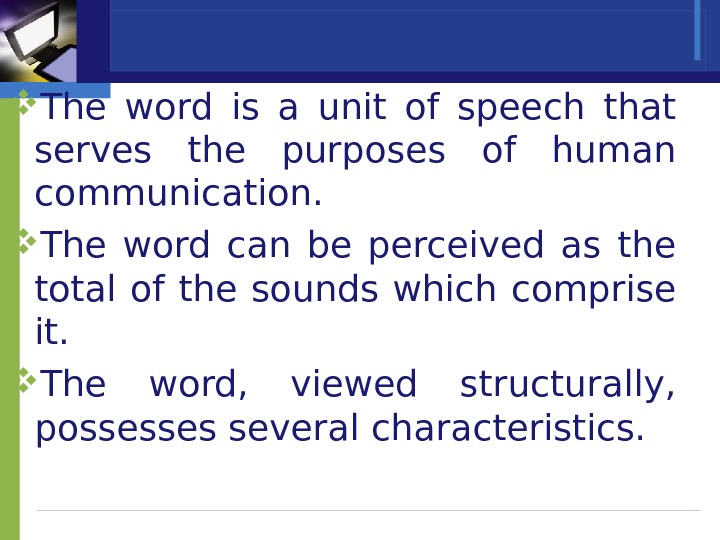

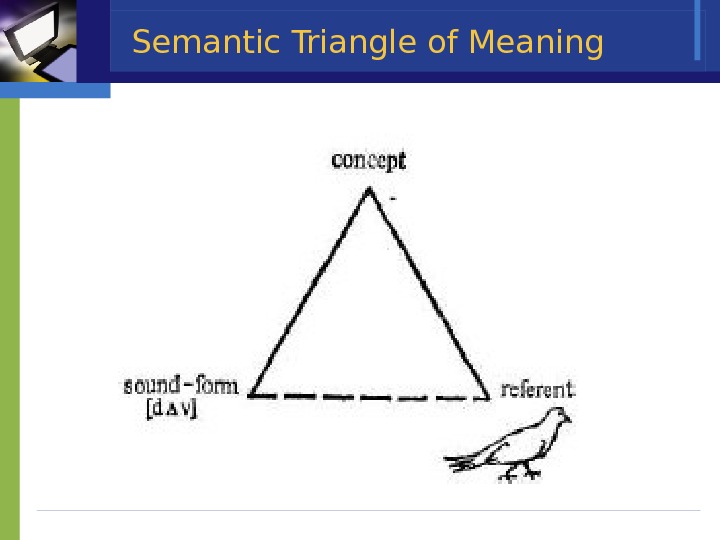
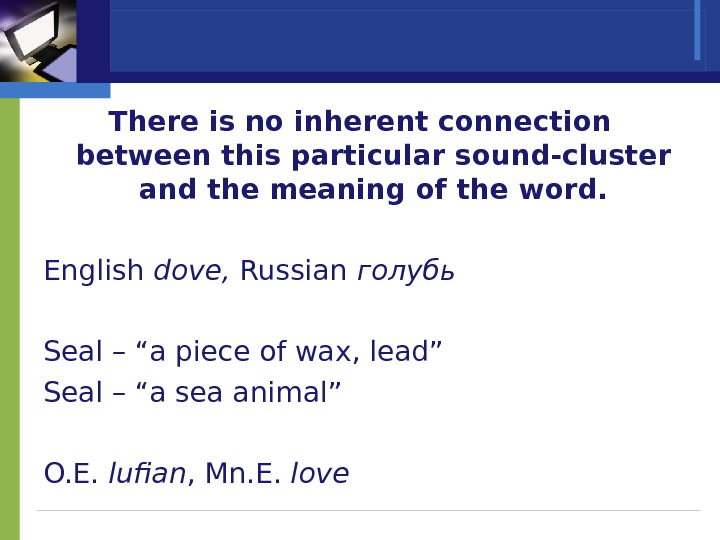

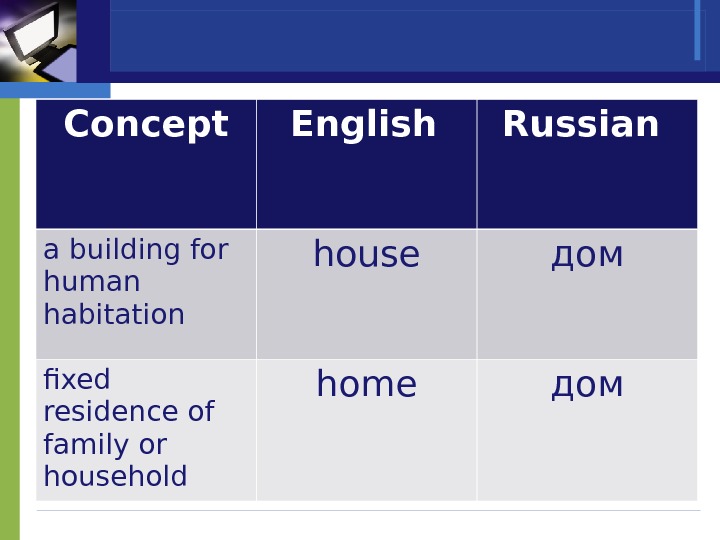


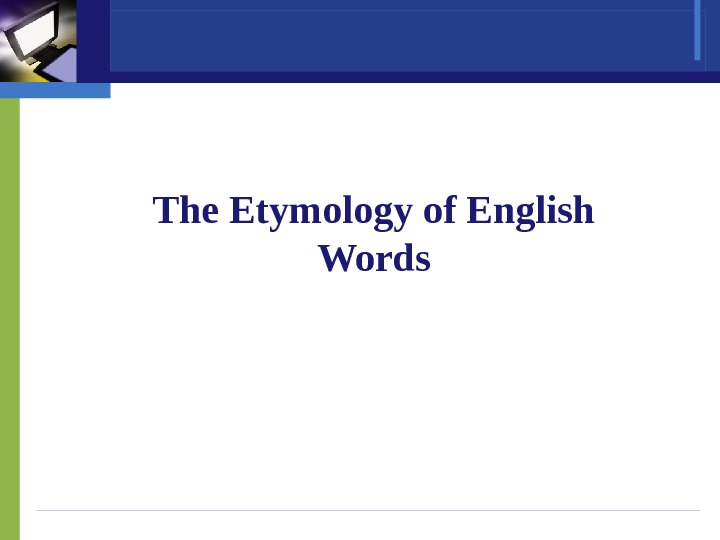
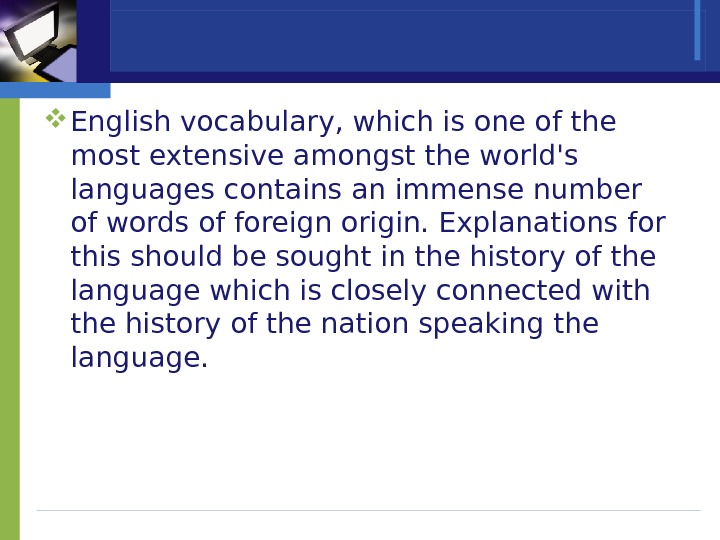
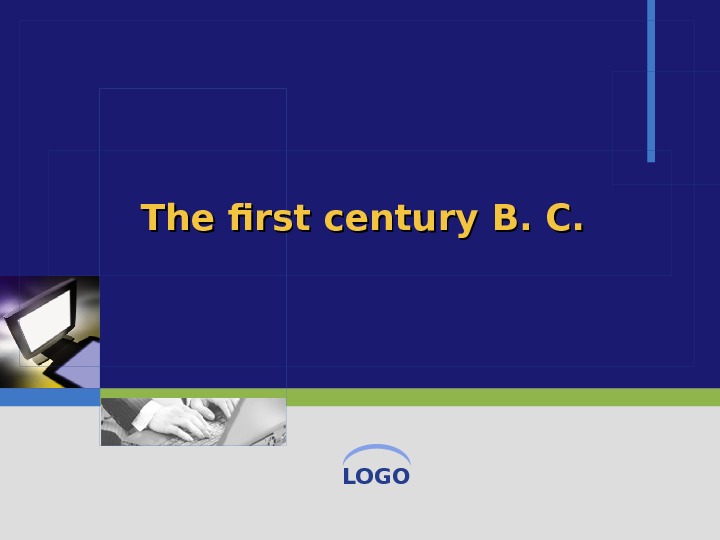

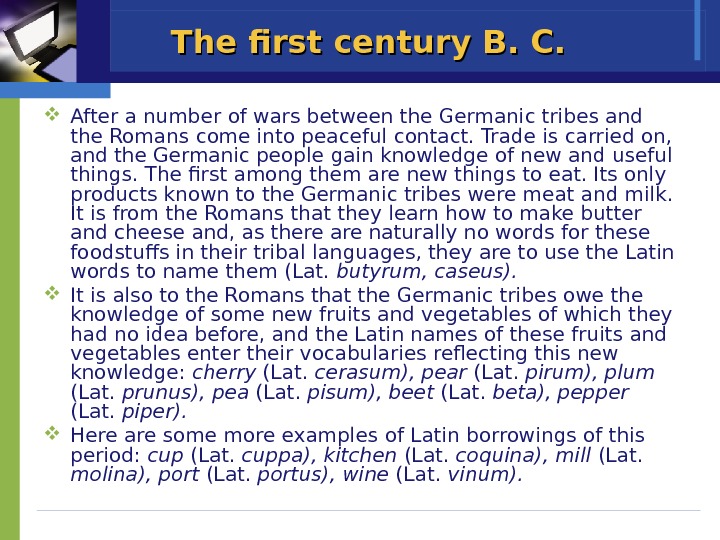

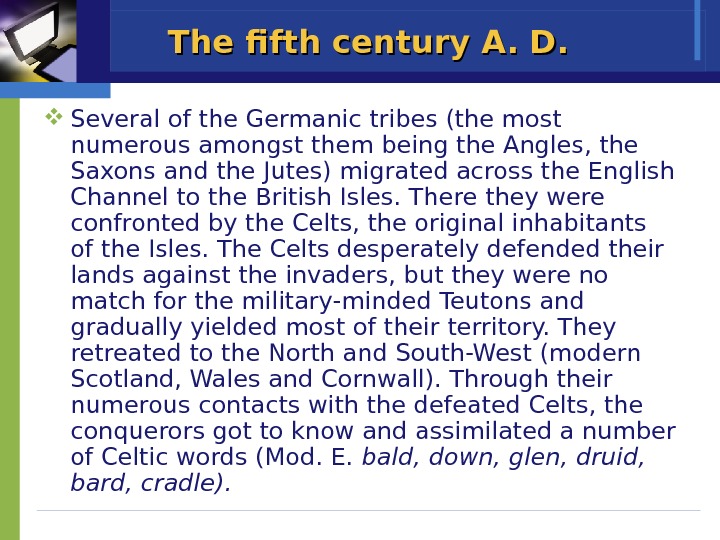
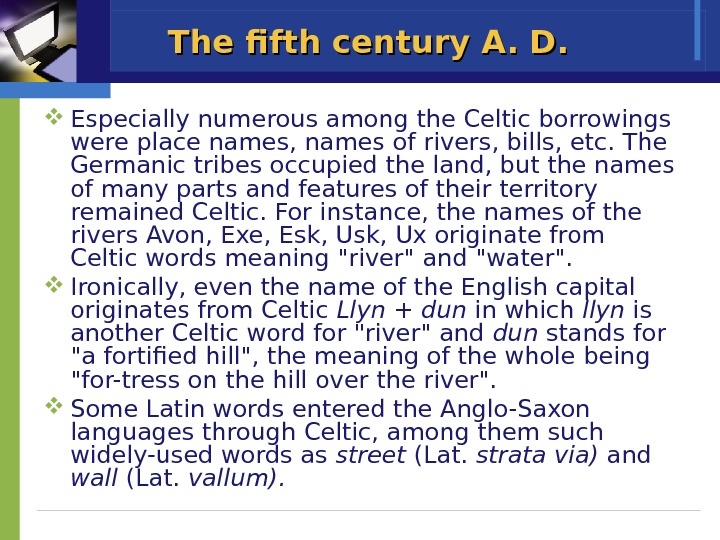
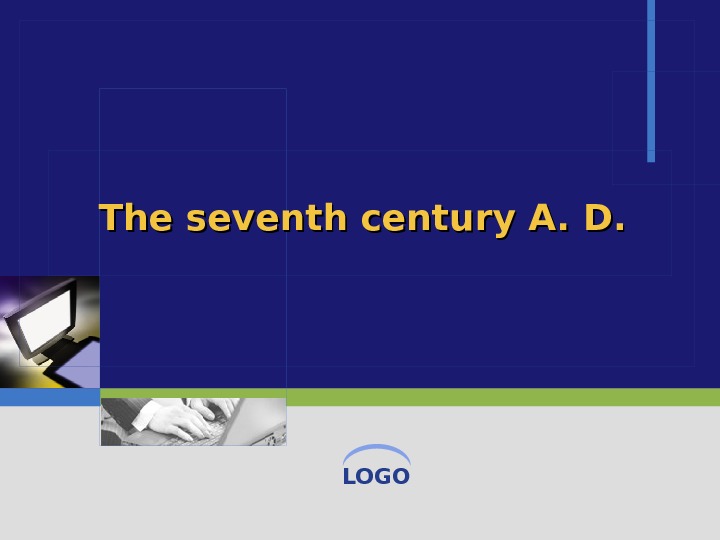
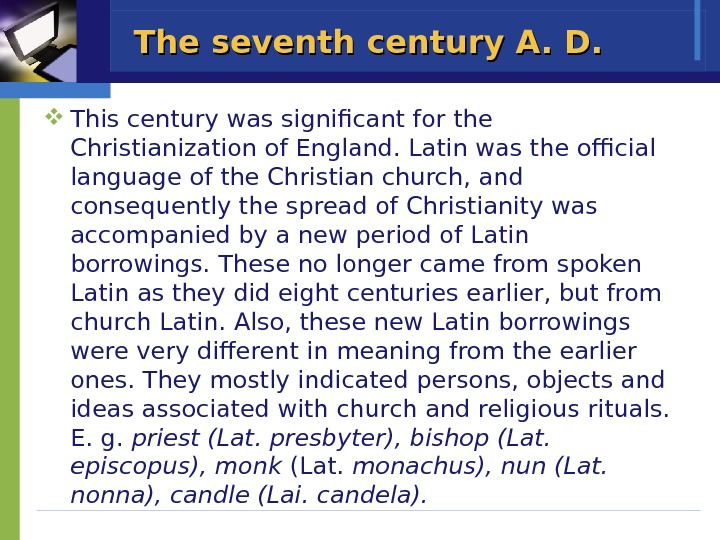

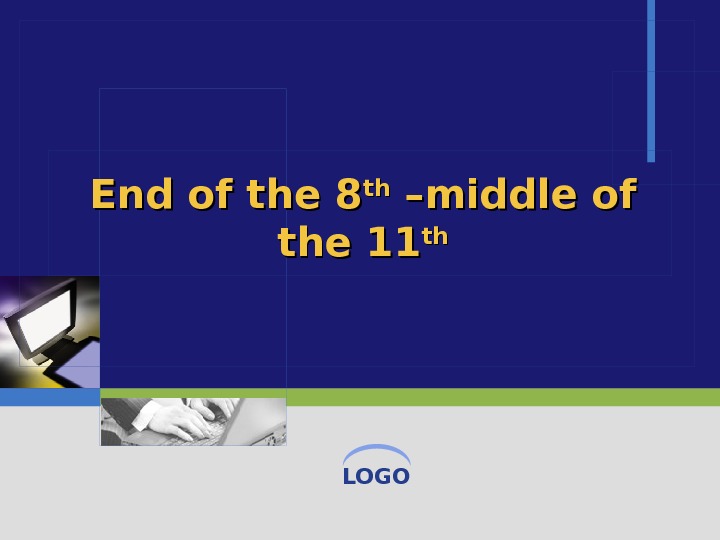
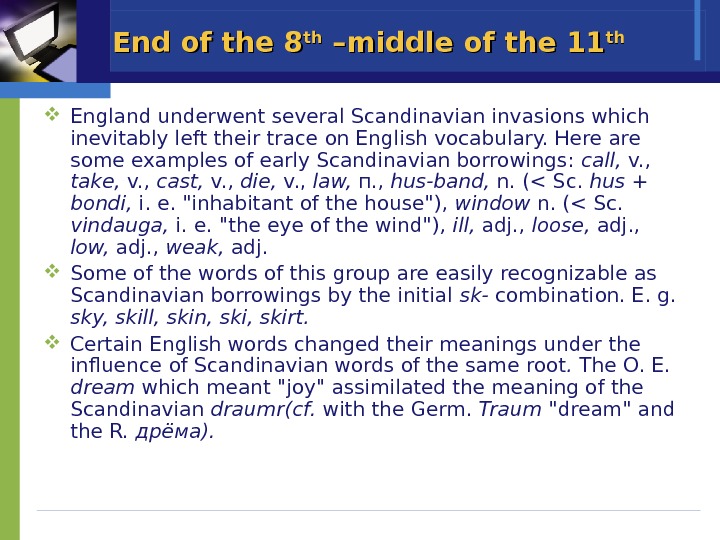

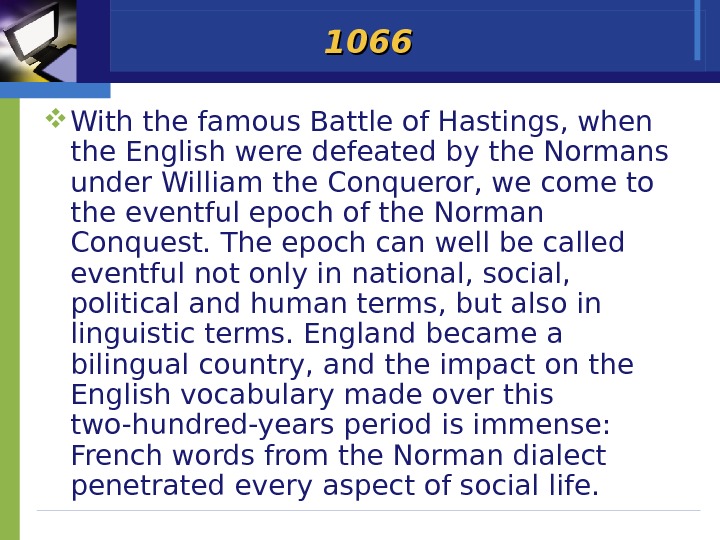



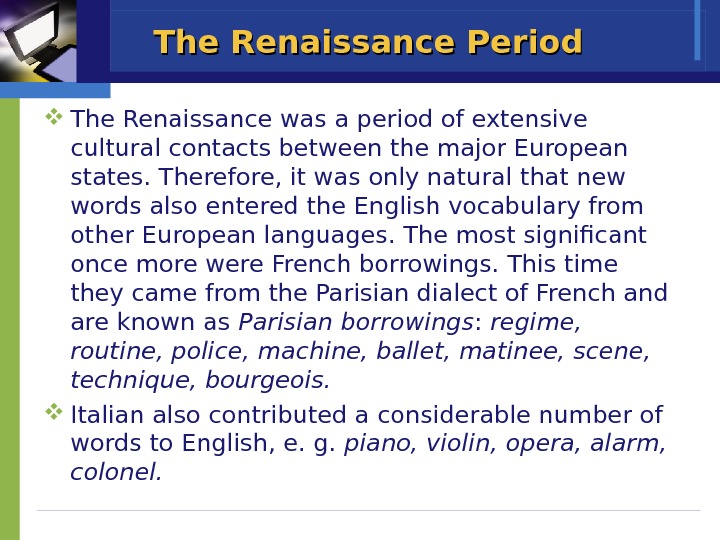



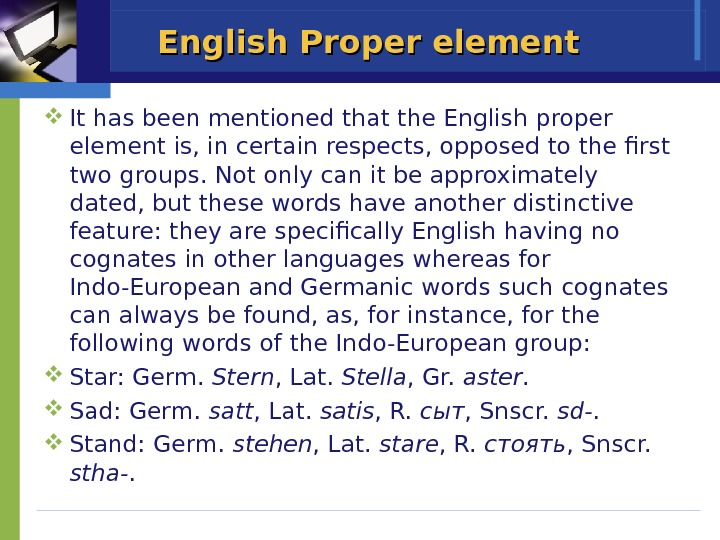

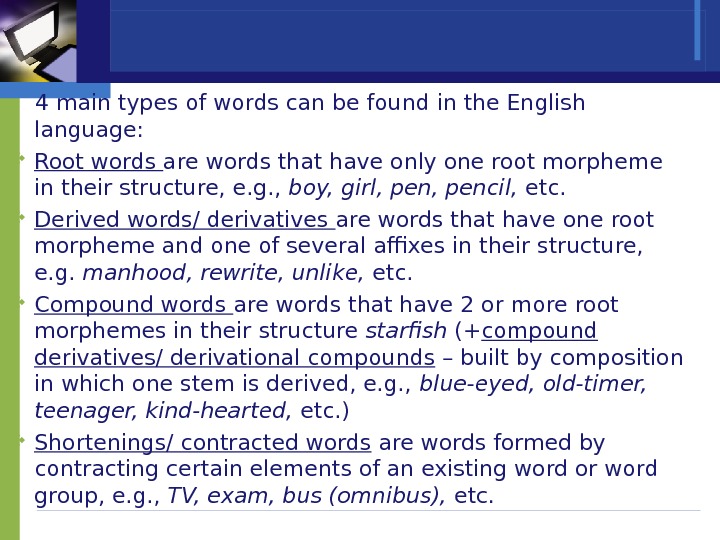
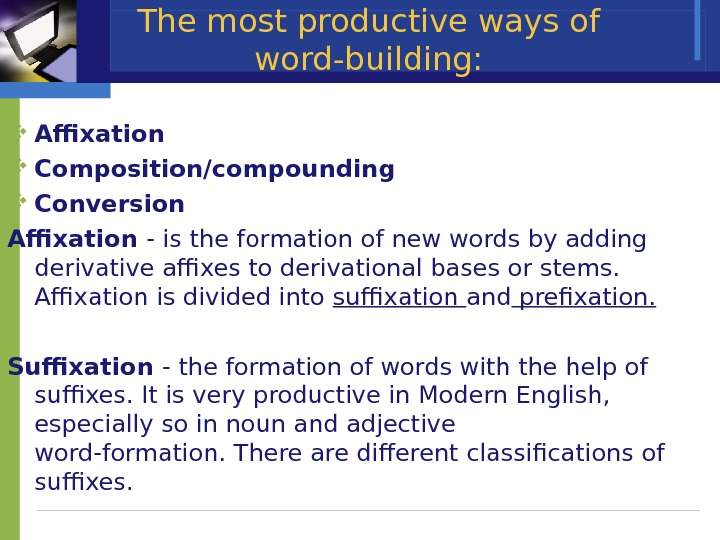
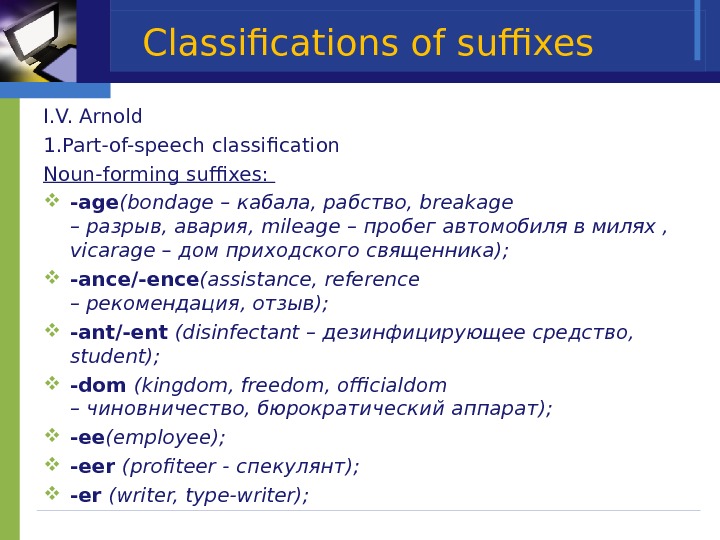


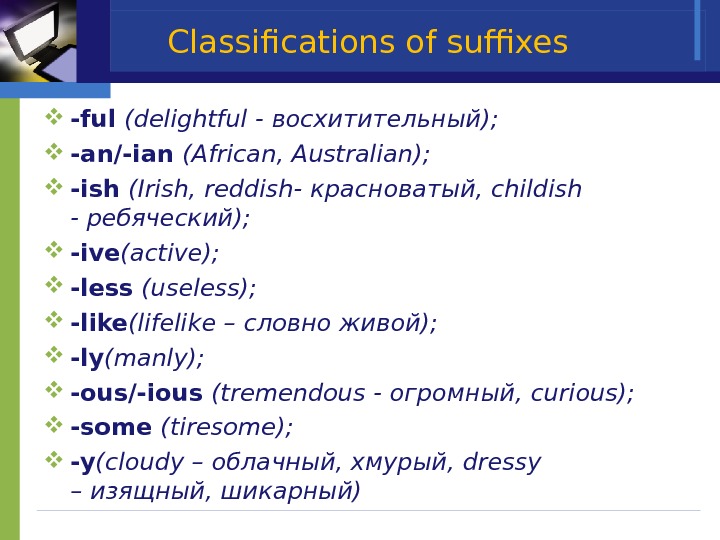
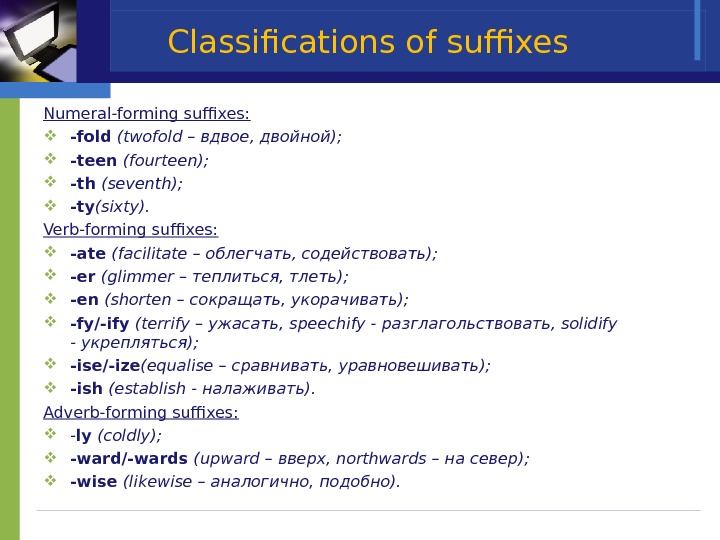
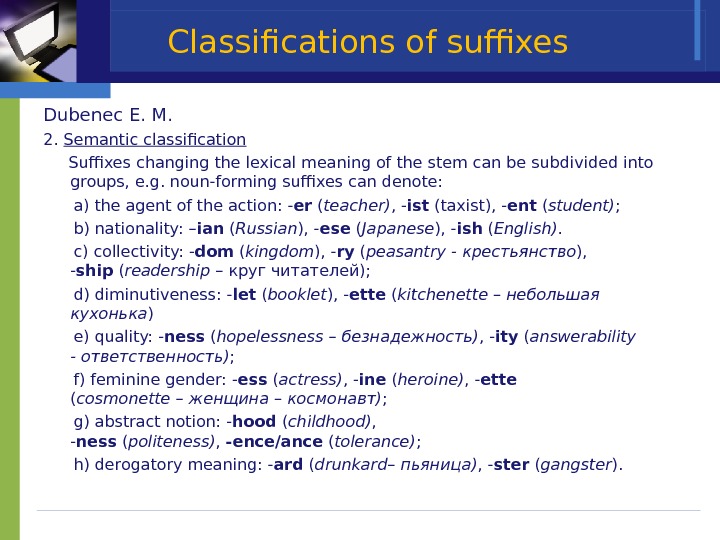


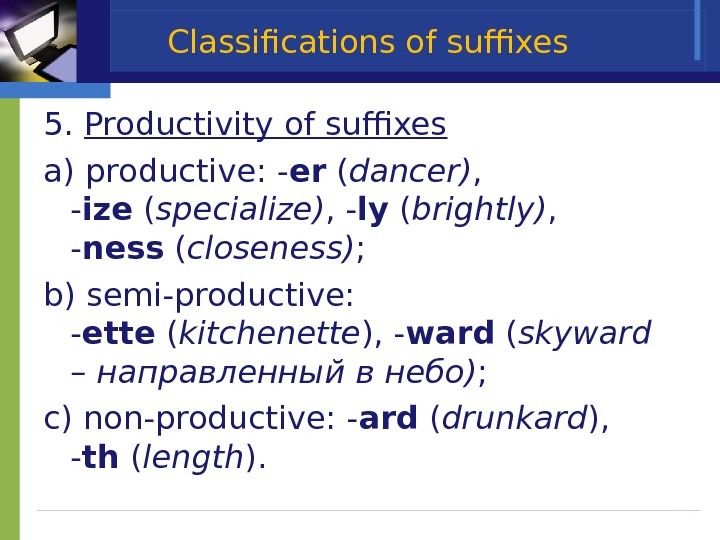
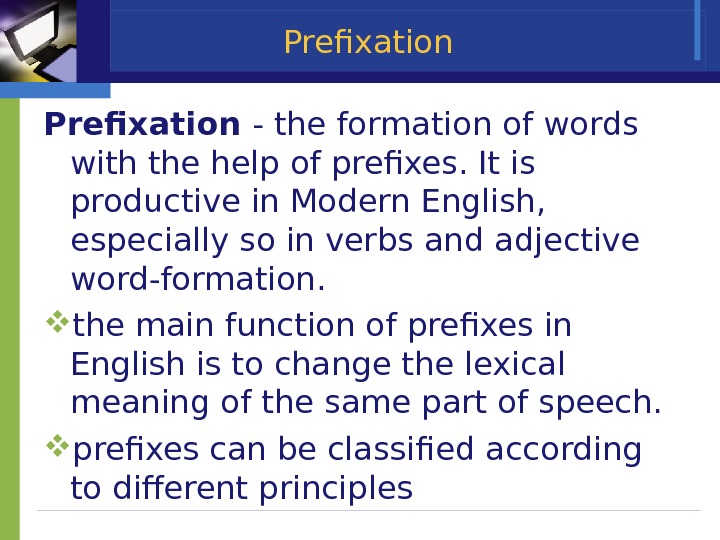
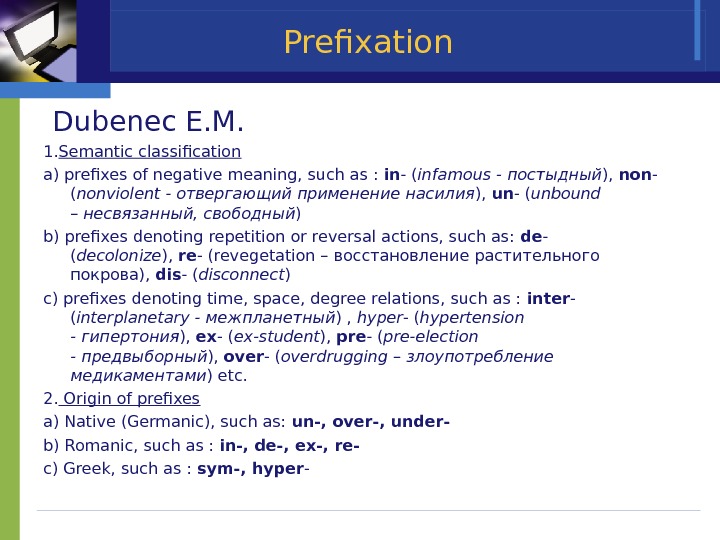
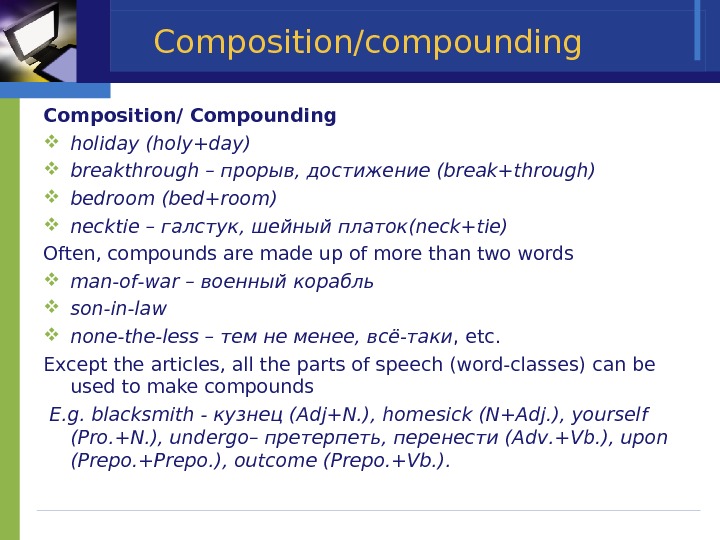
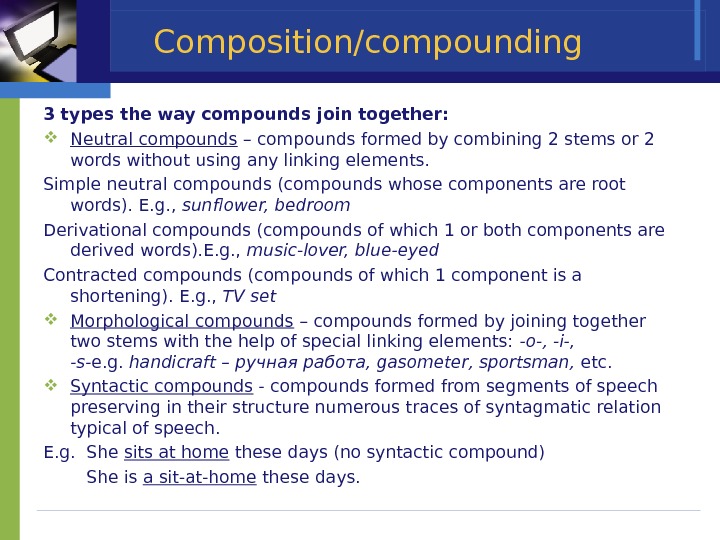
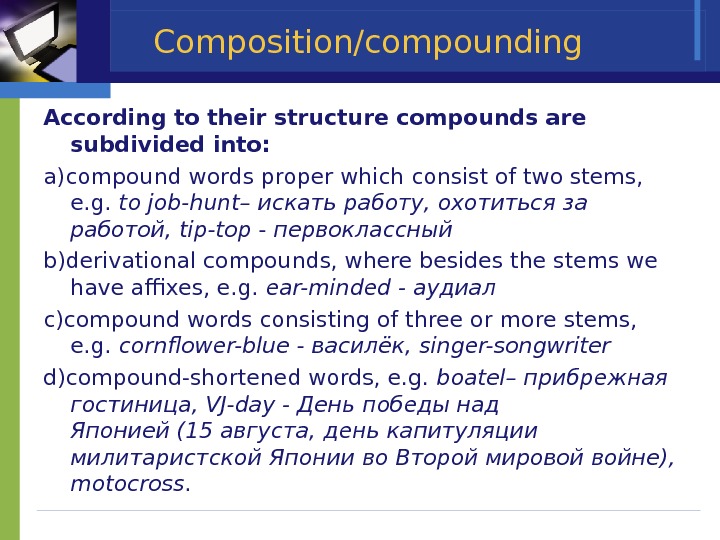
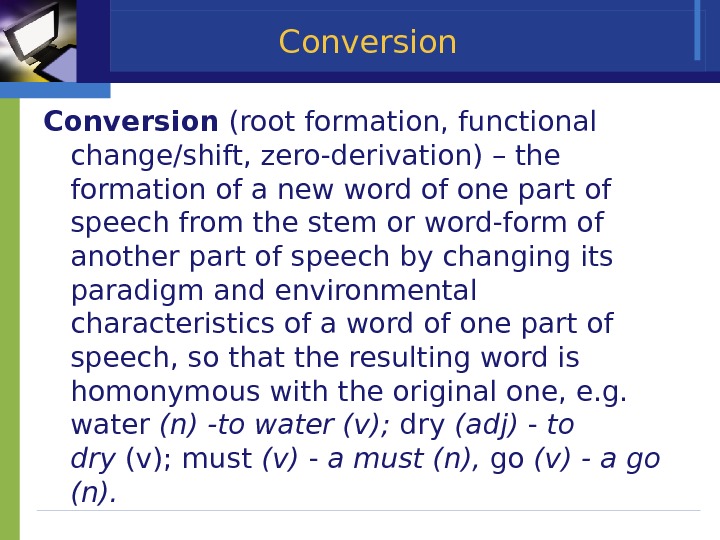
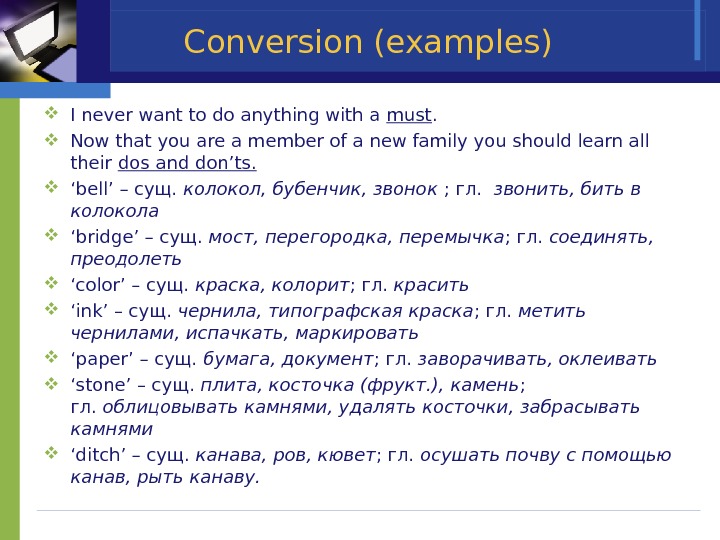
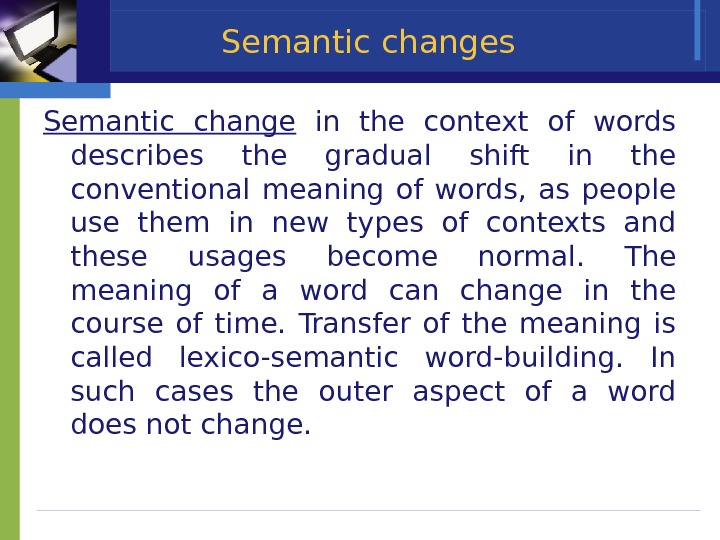



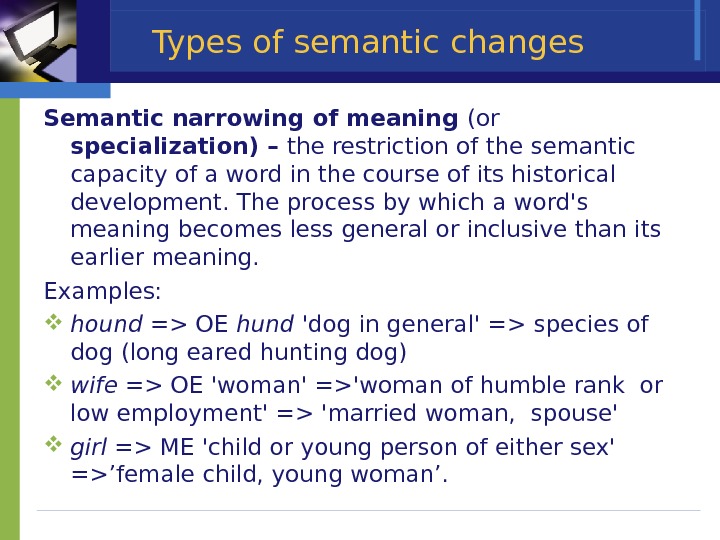



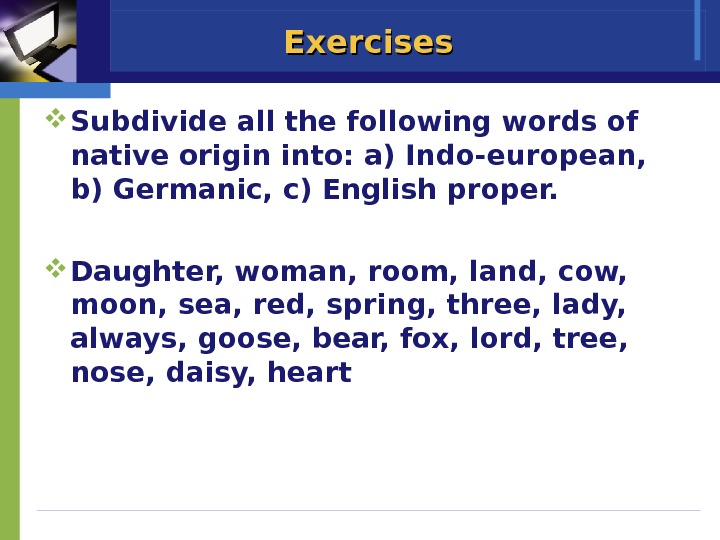

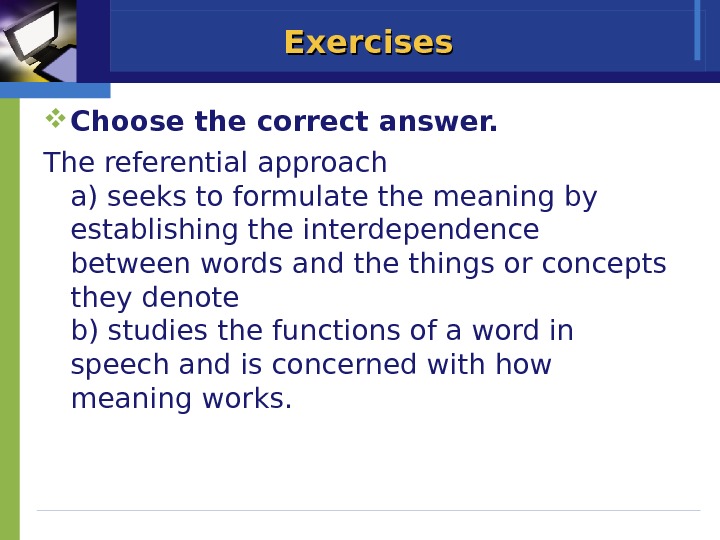
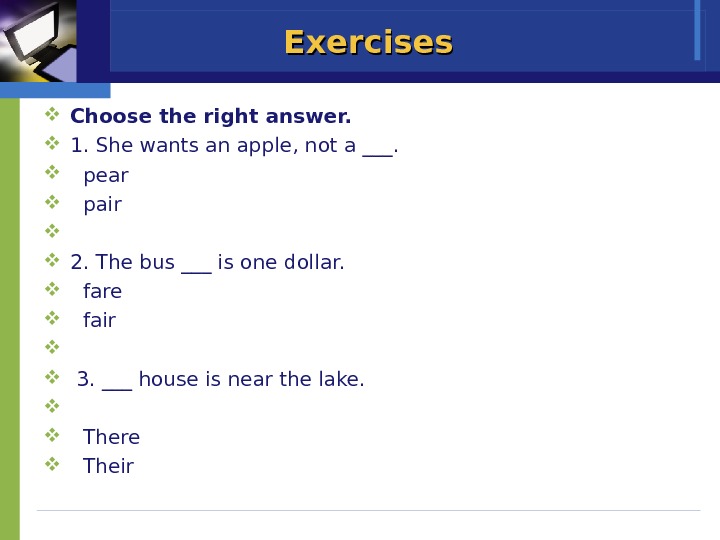
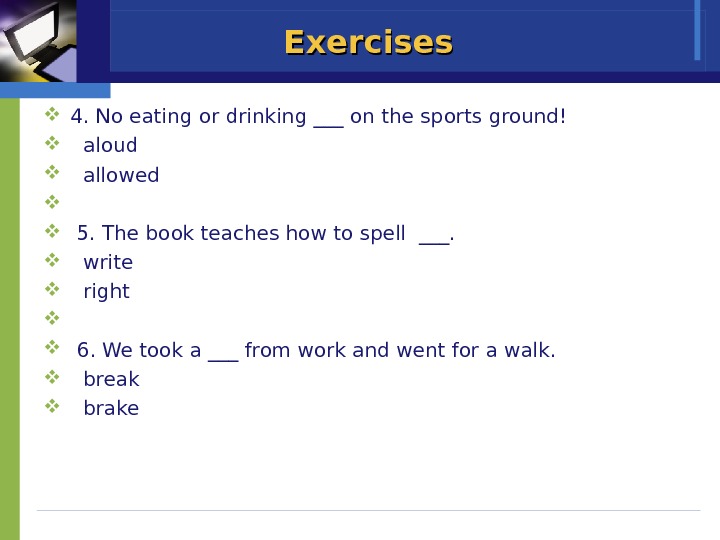
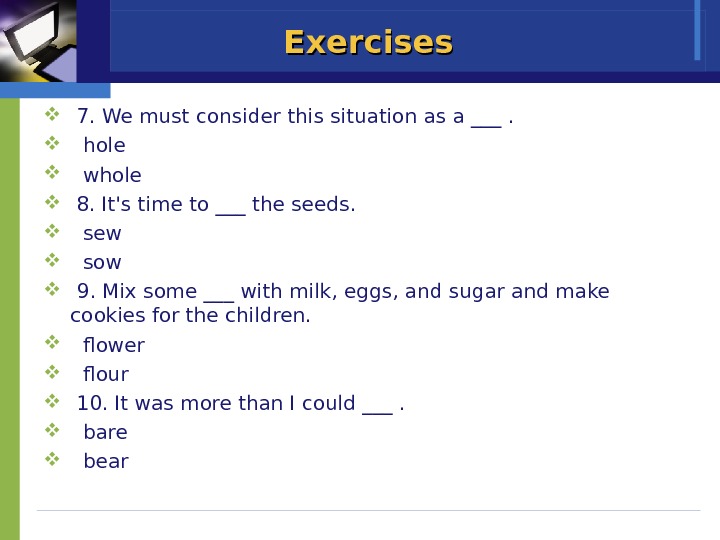
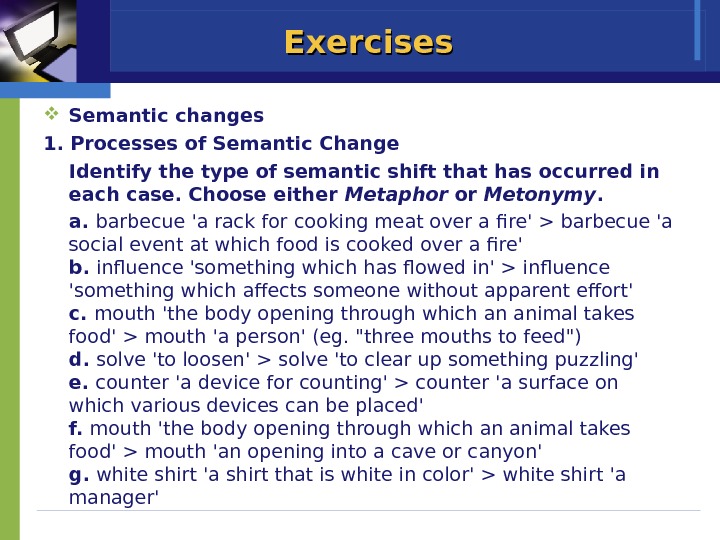
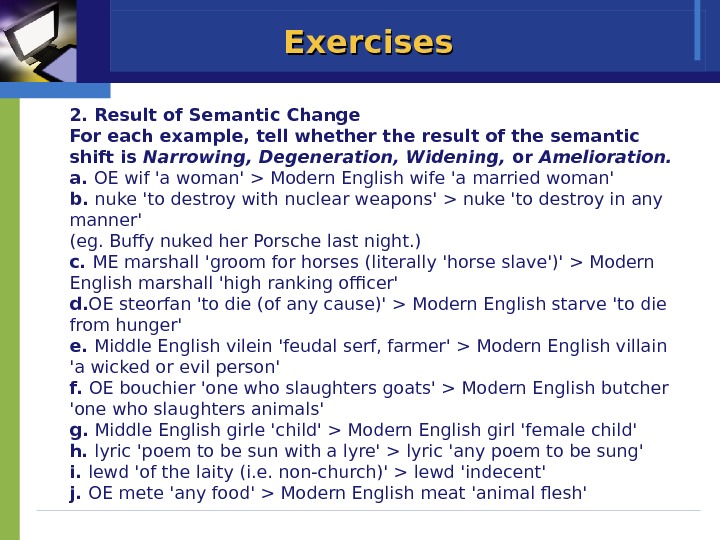
- Размер: 794.5 Кб
- Количество слайдов: 68
Описание презентации Презентация Word as the basic unit of language по слайдам
 LOGOThe Word As The Basic Unit Of The Language
LOGOThe Word As The Basic Unit Of The Language
 Definitions of the term “word ” Word is the basic unit of language. It corresponds to the concept of thing meant and names it. (G. B. Antrushina) The term “word” denotes the basic unit of a given language resulting from the association of a particular meaning with a particular group of sounds capable of a particular grammatical employment. (I. V. Arnold) The word is the basic unit of language system, the largest on the morphologic and the smallest on the syntactic plane of linguistic analysis. The word is a structural and semantic entity within the language system. (R. S. Ginzburg)
Definitions of the term “word ” Word is the basic unit of language. It corresponds to the concept of thing meant and names it. (G. B. Antrushina) The term “word” denotes the basic unit of a given language resulting from the association of a particular meaning with a particular group of sounds capable of a particular grammatical employment. (I. V. Arnold) The word is the basic unit of language system, the largest on the morphologic and the smallest on the syntactic plane of linguistic analysis. The word is a structural and semantic entity within the language system. (R. S. Ginzburg)
 The word is a unit of speech that serves the purposes of human communication. The word can be perceived as the total of the sounds which comprise it. The word, viewed structurally, possesses several characteristics.
The word is a unit of speech that serves the purposes of human communication. The word can be perceived as the total of the sounds which comprise it. The word, viewed structurally, possesses several characteristics.
 Word-meaning Two schools: the referential approach , which seeks to formulate the essence of meaning by establishing the interdependence between words and the things or concepts they denote the functional approach , which studies the functions of a word in speech and is less concerned with what meaning is than with how it works
Word-meaning Two schools: the referential approach , which seeks to formulate the essence of meaning by establishing the interdependence between words and the things or concepts they denote the functional approach , which studies the functions of a word in speech and is less concerned with what meaning is than with how it works
 Semantic Triangle of Meaning
Semantic Triangle of Meaning
 There is no inherent connection between this particular sound-cluster and the meaning of the word. English dove, Russian голубь Seal – “a piece of wax, lead” Seal – “a sea animal” O. E. lufian , Mn. E. love
There is no inherent connection between this particular sound-cluster and the meaning of the word. English dove, Russian голубь Seal – “a piece of wax, lead” Seal – “a sea animal” O. E. lufian , Mn. E. love
 Concept is a category of human cognition. Concept is the thought of the object that singles out its essential features. Our concepts abstract and reflect the most common and typical features of the different objects and phenomena of the world. Being the result of abstraction and generalisation all concepts are almost the same for the whole of humanity in one and the same period of its historical development.
Concept is a category of human cognition. Concept is the thought of the object that singles out its essential features. Our concepts abstract and reflect the most common and typical features of the different objects and phenomena of the world. Being the result of abstraction and generalisation all concepts are almost the same for the whole of humanity in one and the same period of its historical development.
 Concept English Russian a building for human habitation house дом fixed residence of family or household home дом
Concept English Russian a building for human habitation house дом fixed residence of family or household home дом
 The structure of the word External structure (morphological) post-impressionists: prefixes post-, im- root press noun-forming suffixes -ion, -ist grammatical suffix of plurality –s Internal structure (semantic) The word’s meaning The area of lexicology specialising in the semantic studies of the word is called semantics.
The structure of the word External structure (morphological) post-impressionists: prefixes post-, im- root press noun-forming suffixes -ion, -ist grammatical suffix of plurality –s Internal structure (semantic) The word’s meaning The area of lexicology specialising in the semantic studies of the word is called semantics.
 The word’s unity a blackbird a black bird External (formal) unity • Single grammatical framing: blackbirds • The first constituent black cannot be grammatically changed • Other words cannot be inserted between the components • Each constituent can acquire grammatical forms of its own: the blackest birds I’ve ever seen. • Other words can be inserted between the components: a black night bird. Semantic unity • The word blackbird conveys only one concept: the type of bird. • Each of the meaningful words conveys a separate concept: bird — a kind of living creature; black — a colour.
The word’s unity a blackbird a black bird External (formal) unity • Single grammatical framing: blackbirds • The first constituent black cannot be grammatically changed • Other words cannot be inserted between the components • Each constituent can acquire grammatical forms of its own: the blackest birds I’ve ever seen. • Other words can be inserted between the components: a black night bird. Semantic unity • The word blackbird conveys only one concept: the type of bird. • Each of the meaningful words conveys a separate concept: bird — a kind of living creature; black — a colour.
 The Etymology of English Words
The Etymology of English Words
 English vocabulary, which is one of the most extensive amongst the world’s languages contains an immense number of words of foreign origin. Explanations for this should be sought in the history of the language which is closely connected with the history of the nation speaking the language.
English vocabulary, which is one of the most extensive amongst the world’s languages contains an immense number of words of foreign origin. Explanations for this should be sought in the history of the language which is closely connected with the history of the nation speaking the language.
 LOGOThe first century ВВ. . С. С.
LOGOThe first century ВВ. . С. С.
 The first century ВВ. . С. С. Most of the territory is occupied by the Roman Empire. Among the inhabitants of the continent are Germanic tribes, «barbarians». Theirs is really a rather primitive stage of development, especially if compared with the high civilization and refinement of Rome. They are primitive cattle-breeders and know almost nothing about land cultivation. Their tribal languages contain only Indo-European and Germanic elements.
The first century ВВ. . С. С. Most of the territory is occupied by the Roman Empire. Among the inhabitants of the continent are Germanic tribes, «barbarians». Theirs is really a rather primitive stage of development, especially if compared with the high civilization and refinement of Rome. They are primitive cattle-breeders and know almost nothing about land cultivation. Their tribal languages contain only Indo-European and Germanic elements.
 The first century ВВ. . С. С. After a number of wars between the Germanic tribes and the Romans come into peaceful contact. Trade is carried on, and the Germanic people gain knowledge of new and useful things. The first among them are new things to eat. Its only products known to the Germanic tribes were meat and milk. It is from the Romans that they learn how to make butter and cheese and, as there are naturally no words for these foodstuffs in their tribal languages, they are to use the Latin words to name them (Lat. butyrum, caseus). It is also to the Romans that the Germanic tribes owe the knowledge of some new fruits and vegetables of which they had no idea before, and the Latin names of these fruits and vegetables enter their vocabularies reflecting this new knowledge: cherry (Lat. cerasum), pear (Lat. pirum), plum (Lat. prunus), pea (Lat. pisum), beet (Lat. beta), pepper (Lat. piper). Here are some more examples of Latin borrowings of this period: cup (Lat. cuppa), kitchen (Lat. coquina), mill (Lat. molina), port (Lat. portus), wine (Lat. vinum).
The first century ВВ. . С. С. After a number of wars between the Germanic tribes and the Romans come into peaceful contact. Trade is carried on, and the Germanic people gain knowledge of new and useful things. The first among them are new things to eat. Its only products known to the Germanic tribes were meat and milk. It is from the Romans that they learn how to make butter and cheese and, as there are naturally no words for these foodstuffs in their tribal languages, they are to use the Latin words to name them (Lat. butyrum, caseus). It is also to the Romans that the Germanic tribes owe the knowledge of some new fruits and vegetables of which they had no idea before, and the Latin names of these fruits and vegetables enter their vocabularies reflecting this new knowledge: cherry (Lat. cerasum), pear (Lat. pirum), plum (Lat. prunus), pea (Lat. pisum), beet (Lat. beta), pepper (Lat. piper). Here are some more examples of Latin borrowings of this period: cup (Lat. cuppa), kitchen (Lat. coquina), mill (Lat. molina), port (Lat. portus), wine (Lat. vinum).
 LOGOThe fifth century A. D.
LOGOThe fifth century A. D.
 The fifth century A. D. Several of the Germanic tribes (the most numerous amongst them being the Angles, the Saxons and the Jutes) migrated across the English Channel to the British Isles. There they were confronted by the Celts, the original inhabitants of the Isles. The Celts desperately defended their lands against the invaders, but they were no match for the military-minded Teutons and gradually yielded most of their territory. They retreated to the North and South-West (modern Scotland, Wales and Cornwall). Through their numerous contacts with the defeated Celts, the conquerors got to know and assimilated a number of Celtic words (Mod. E. bald, down, glen, druid, bard, cradle).
The fifth century A. D. Several of the Germanic tribes (the most numerous amongst them being the Angles, the Saxons and the Jutes) migrated across the English Channel to the British Isles. There they were confronted by the Celts, the original inhabitants of the Isles. The Celts desperately defended their lands against the invaders, but they were no match for the military-minded Teutons and gradually yielded most of their territory. They retreated to the North and South-West (modern Scotland, Wales and Cornwall). Through their numerous contacts with the defeated Celts, the conquerors got to know and assimilated a number of Celtic words (Mod. E. bald, down, glen, druid, bard, cradle).
 The fifth century A. D. Especially numerous among the Celtic borrowings were place names, names of rivers, bills, etc. The Germanic tribes occupied the land, but the names of many parts and features of their territory remained Celtic. For instance, the names of the rivers Avon, Exe, Esk, Ux originate from Celtic words meaning «river» and «water». Ironically, even the name of the English capital originates from Celtic Llyn + dun in which llyn is another Celtic word for «river» and dun stands for «a fortified hill», the meaning of the whole being «for-tress on the hill over the river». Some Latin words entered the Anglo-Saxon languages through Celtic, among them such widely-used words as street (Lat. strata via) and wall (Lat. vallum).
The fifth century A. D. Especially numerous among the Celtic borrowings were place names, names of rivers, bills, etc. The Germanic tribes occupied the land, but the names of many parts and features of their territory remained Celtic. For instance, the names of the rivers Avon, Exe, Esk, Ux originate from Celtic words meaning «river» and «water». Ironically, even the name of the English capital originates from Celtic Llyn + dun in which llyn is another Celtic word for «river» and dun stands for «a fortified hill», the meaning of the whole being «for-tress on the hill over the river». Some Latin words entered the Anglo-Saxon languages through Celtic, among them such widely-used words as street (Lat. strata via) and wall (Lat. vallum).
 LOGOThe seventh century A. D.
LOGOThe seventh century A. D.
 The seventh century A. D. This century was significant for the Christianization of England. Latin was the official language of the Christian church, and consequently the spread of Christianity was accompanied by a new period of Latin borrowings. These no longer came from spoken Latin as they did eight centuries earlier, but from church Latin. Also, these new Latin borrowings were very different in meaning from the earlier ones. They mostly indicated persons, objects and ideas associated with church and religious rituals. E. g. priest (Lat. presbyter), bishop (Lat. episcopus), monk (Lat. monachus), nun (Lat. nonna), candle (Lai. candela).
The seventh century A. D. This century was significant for the Christianization of England. Latin was the official language of the Christian church, and consequently the spread of Christianity was accompanied by a new period of Latin borrowings. These no longer came from spoken Latin as they did eight centuries earlier, but from church Latin. Also, these new Latin borrowings were very different in meaning from the earlier ones. They mostly indicated persons, objects and ideas associated with church and religious rituals. E. g. priest (Lat. presbyter), bishop (Lat. episcopus), monk (Lat. monachus), nun (Lat. nonna), candle (Lai. candela).
 The seventh century A. D. Additionally, in a class of their own were educational terms. It was quite natural that these were also Latin borrowings, for the first schools in England were church schools, and the first teachers priests and monks. So, the very word school is a Latin borrowing (Lat. schola, of Greek origin) and so are such words as scholar (Lat. scholar(-is) and magister (Lat. ma-gister).
The seventh century A. D. Additionally, in a class of their own were educational terms. It was quite natural that these were also Latin borrowings, for the first schools in England were church schools, and the first teachers priests and monks. So, the very word school is a Latin borrowing (Lat. schola, of Greek origin) and so are such words as scholar (Lat. scholar(-is) and magister (Lat. ma-gister).
 LOGOEnd of the 8 thth –middle of the 11 thth
LOGOEnd of the 8 thth –middle of the 11 thth
 End of the 8 thth –middle of the 11 thth England underwent several Scandinavian invasions which inevitably left their trace on English vocabulary. Here are some examples of early Scandinavian borrowings: call, v. , take, v. , cast, v. , die, v. , law, п. , hus-band, n. (< Sc. hus + bondi, i. e. "inhabitant of the house"), window n. (< Sc. vindauga, i. e. "the eye of the wind"), ill, adj. , loose, adj. , low, adj. , weak, adj. Some of the words of this group are easily recognizable as Scandinavian borrowings by the initial sk- combination. E. g. sky, skill, skin, skirt. Certain English words changed their meanings under the influence of Scandinavian words of the same root. The О. Е. dream which meant "joy" assimilated the meaning of the Scandinavian draumr(cf. with the Germ. Traum "dream" and the R. дрёма ).
End of the 8 thth –middle of the 11 thth England underwent several Scandinavian invasions which inevitably left their trace on English vocabulary. Here are some examples of early Scandinavian borrowings: call, v. , take, v. , cast, v. , die, v. , law, п. , hus-band, n. (< Sc. hus + bondi, i. e. "inhabitant of the house"), window n. (< Sc. vindauga, i. e. "the eye of the wind"), ill, adj. , loose, adj. , low, adj. , weak, adj. Some of the words of this group are easily recognizable as Scandinavian borrowings by the initial sk- combination. E. g. sky, skill, skin, skirt. Certain English words changed their meanings under the influence of Scandinavian words of the same root. The О. Е. dream which meant "joy" assimilated the meaning of the Scandinavian draumr(cf. with the Germ. Traum "dream" and the R. дрёма ).
 LOGO
LOGO
 1066 With the famous Battle of Hastings, when the English were defeated by the Normans under William the Conqueror, we come to the eventful epoch of the Norman Conquest. The epoch can well be called eventful not only in national, social, political and human terms, but also in linguistic terms. England became a bilingual country, and the impact on the English vocabulary made over this two-hundred-years period is immense: French words from the Norman dialect penetrated every aspect of social life.
1066 With the famous Battle of Hastings, when the English were defeated by the Normans under William the Conqueror, we come to the eventful epoch of the Norman Conquest. The epoch can well be called eventful not only in national, social, political and human terms, but also in linguistic terms. England became a bilingual country, and the impact on the English vocabulary made over this two-hundred-years period is immense: French words from the Norman dialect penetrated every aspect of social life.
 1066 Norman French borrowings: Administrative words: state, government, parliament, council, power Legal terms: court, judge, justice, crime, prison Military terms: army, war, soldier, officer, battle, enemy Educational terms: pupil, lesson, library, science, pen, pencil table, plate, saucer, dinner, supper, river, autumn, uncle Numerous terms of everyday: table, plate, saucer, dinner, supper, river, autumn, uncle
1066 Norman French borrowings: Administrative words: state, government, parliament, council, power Legal terms: court, judge, justice, crime, prison Military terms: army, war, soldier, officer, battle, enemy Educational terms: pupil, lesson, library, science, pen, pencil table, plate, saucer, dinner, supper, river, autumn, uncle Numerous terms of everyday: table, plate, saucer, dinner, supper, river, autumn, uncle
 LOGOThe Renaissance Period
LOGOThe Renaissance Period
 The Renaissance Period In England, as in all European countries, this period was marked by significant developments in science, art and culture and, also, by a revival of interest in the ancient civilizations of Greece and Rome and their languages. There occurred a considerable number of Latin and Greek borrowings. In contrast to the earliest Latin borrowings (1 st с. В. С. ), the Renaissance ones were rarely concrete names. They were mostly abstract words (e. g. major, minor, filial, moderate, intelligent, permanent, to elect, to create). There were naturally numerous scientific and artistic terms (datum, status, phenomenon, philosophy, method, music). The same is true of Greek Renaissance borrowings (e. g. atom, cycle, ethics, esthete).
The Renaissance Period In England, as in all European countries, this period was marked by significant developments in science, art and culture and, also, by a revival of interest in the ancient civilizations of Greece and Rome and their languages. There occurred a considerable number of Latin and Greek borrowings. In contrast to the earliest Latin borrowings (1 st с. В. С. ), the Renaissance ones were rarely concrete names. They were mostly abstract words (e. g. major, minor, filial, moderate, intelligent, permanent, to elect, to create). There were naturally numerous scientific and artistic terms (datum, status, phenomenon, philosophy, method, music). The same is true of Greek Renaissance borrowings (e. g. atom, cycle, ethics, esthete).
 The Renaissance Period The Renaissance was a period of extensive cultural contacts between the major European states. Therefore, it was only natural that new words also entered the English vocabulary from other European languages. The most significant once more were French borrowings. This time they came from the Parisian dialect of French and are known as Parisian borrowings : regime, routine, police, machine, ballet, matinee, scene, technique, bourgeois. Italian also contributed a considerable number of words to English, e. g. piano, violin, opera, alarm, colonel.
The Renaissance Period The Renaissance was a period of extensive cultural contacts between the major European states. Therefore, it was only natural that new words also entered the English vocabulary from other European languages. The most significant once more were French borrowings. This time they came from the Parisian dialect of French and are known as Parisian borrowings : regime, routine, police, machine, ballet, matinee, scene, technique, bourgeois. Italian also contributed a considerable number of words to English, e. g. piano, violin, opera, alarm, colonel.
 The Etymological Structure of English Vocabulary The native element Indo-European element Germanic element English Proper element (no earlier than 5 th c. A. D. ) The borrowed element Celtic (5 th — 6 th c. A. D. ) Latin (1 st group: 1 st с. В. С. 2 nd group: 7 th c. A. D. 3 rd group: the Renaissance period) Scandinavian (8 th — 11 th c. A. D. ) French (1. Norman borrowings: 11 th — 13 th c. A. D. 2. Parisian borrowings (Renaissance)) Greek (Renaissance) Italian, Spanish (Renaissance and later) German, Indian, Russian and some other groups
The Etymological Structure of English Vocabulary The native element Indo-European element Germanic element English Proper element (no earlier than 5 th c. A. D. ) The borrowed element Celtic (5 th — 6 th c. A. D. ) Latin (1 st group: 1 st с. В. С. 2 nd group: 7 th c. A. D. 3 rd group: the Renaissance period) Scandinavian (8 th — 11 th c. A. D. ) French (1. Norman borrowings: 11 th — 13 th c. A. D. 2. Parisian borrowings (Renaissance)) Greek (Renaissance) Italian, Spanish (Renaissance and later) German, Indian, Russian and some other groups
 Indo-European element By the Indo-European element are meant words of roots common to all or most languages of the Indo-European group. English words of this group denote elementary concepts without which no human communication would be possible. The following groups can be identified: I. Family relations: father, mother, brother, son, daughter. II. Parts of the human body: foot, nose, lip, heart. III. Animals: cow, swine, goose. IV. Plants: tree, birch, corn V. Time of day: day, night. VI. Heavenly bodies: sun, moon, star. VII. Numerous adjectives: red, new, glad, sad. VIII. The numerals from one to a hundred. IX. Pronouns — personal (except they which is a Scandinavian borrowing); demonstrative. X. Numerous verbs: be, stand, sit, eat, know
Indo-European element By the Indo-European element are meant words of roots common to all or most languages of the Indo-European group. English words of this group denote elementary concepts without which no human communication would be possible. The following groups can be identified: I. Family relations: father, mother, brother, son, daughter. II. Parts of the human body: foot, nose, lip, heart. III. Animals: cow, swine, goose. IV. Plants: tree, birch, corn V. Time of day: day, night. VI. Heavenly bodies: sun, moon, star. VII. Numerous adjectives: red, new, glad, sad. VIII. The numerals from one to a hundred. IX. Pronouns — personal (except they which is a Scandinavian borrowing); demonstrative. X. Numerous verbs: be, stand, sit, eat, know
 The Germanic element represents words of roots common to all or most Germanic languages. Some of the main groups of Germanic words are the same as in the Indo-European element. I. Parts of the human body: head, hand, arm, finger, bone. II. Animals: bear, fox, calf. III. Plants: oak, fir, grass. IV. Natural phenomena: rain, frost. V. Seasons of the year: winter, spring, summer. VI. Landscape features: sea, land. VII. Human dwellings and furniture: house, room, bench. VIII. Sea-going vessels: boat, ship. IX. Adjectives: green, blue, grey, white, small, thick, high, old, good. X. Verbs: see, hear, speak, tell, say, answer, make, give, drink.
The Germanic element represents words of roots common to all or most Germanic languages. Some of the main groups of Germanic words are the same as in the Indo-European element. I. Parts of the human body: head, hand, arm, finger, bone. II. Animals: bear, fox, calf. III. Plants: oak, fir, grass. IV. Natural phenomena: rain, frost. V. Seasons of the year: winter, spring, summer. VI. Landscape features: sea, land. VII. Human dwellings and furniture: house, room, bench. VIII. Sea-going vessels: boat, ship. IX. Adjectives: green, blue, grey, white, small, thick, high, old, good. X. Verbs: see, hear, speak, tell, say, answer, make, give, drink.
 English Proper element It has been mentioned that the English proper element is, in certain respects, opposed to the first two groups. Not only can it be approximately dated, but these words have another distinctive feature: they are specifically English having no cognates in other languages whereas for Indo-European and Germanic words such cognates can always be found, as, for instance, for the following words of the Indo-European group: Star: Germ. Stern , Lat. Stella , Gr. aster. Sad: Germ. satt , Lat. satis , R. сыт , Snscr. sd-. Stand: Germ. stehen , Lat. stare , R. стоять , Snscr. stha-.
English Proper element It has been mentioned that the English proper element is, in certain respects, opposed to the first two groups. Not only can it be approximately dated, but these words have another distinctive feature: they are specifically English having no cognates in other languages whereas for Indo-European and Germanic words such cognates can always be found, as, for instance, for the following words of the Indo-European group: Star: Germ. Stern , Lat. Stella , Gr. aster. Sad: Germ. satt , Lat. satis , R. сыт , Snscr. sd-. Stand: Germ. stehen , Lat. stare , R. стоять , Snscr. stha-.
 English Proper element Here are some examples of English proper words. These words stand quite alone in the vocabulary system of Indo-European languages: bird, boy, girl, lord, lady, woman, daisy, always.
English Proper element Here are some examples of English proper words. These words stand quite alone in the vocabulary system of Indo-European languages: bird, boy, girl, lord, lady, woman, daisy, always.
 4 main types of words can be found in the English language: Root words are words that have only one root morpheme in their structure, e. g. , boy, girl, pencil, etc. Derived words/ derivatives are words that have one root morpheme and one of several affixes in their structure, e. g. manhood, rewrite, unlike, etc. Compound words are words that have 2 or more root morphemes in their structure starfish (+ compound derivatives/ derivational compounds – built by composition in which one stem is derived, e. g. , blue-eyed, old-timer, teenager, kind-hearted, etc. ) Shortenings/ contracted words are words formed by contracting certain elements of an existing word or word group, e. g. , TV, exam, bus (omnibus), etc.
4 main types of words can be found in the English language: Root words are words that have only one root morpheme in their structure, e. g. , boy, girl, pencil, etc. Derived words/ derivatives are words that have one root morpheme and one of several affixes in their structure, e. g. manhood, rewrite, unlike, etc. Compound words are words that have 2 or more root morphemes in their structure starfish (+ compound derivatives/ derivational compounds – built by composition in which one stem is derived, e. g. , blue-eyed, old-timer, teenager, kind-hearted, etc. ) Shortenings/ contracted words are words formed by contracting certain elements of an existing word or word group, e. g. , TV, exam, bus (omnibus), etc.
 The most productive ways of word-building: Affixation С omposition/compounding С onversion Affixation — is the formation of new words by adding derivative affixes to derivational bases or stems. Affixation is divided into suffixation and prefixation. Suffixation — the formation of words with the help of suffixes. It is very productive in Modern English, especially so in noun and adjective word-formation. There are different classifications of suffixes.
The most productive ways of word-building: Affixation С omposition/compounding С onversion Affixation — is the formation of new words by adding derivative affixes to derivational bases or stems. Affixation is divided into suffixation and prefixation. Suffixation — the formation of words with the help of suffixes. It is very productive in Modern English, especially so in noun and adjective word-formation. There are different classifications of suffixes.
 Classifications of suffixes I. V. Arnold 1. Part-of-speech classification Noun-forming suffixes: -age (bondage – кабала, рабство, breakage – разрыв, авария, mileage – пробег автомобиля в милях, vicarage – дом приходского священника); — ance/-ence (assistance, reference – рекомендация, отзыв); — ant/-ent (disinfectant – дезинфицирующее средство, student); -dom (kingdom, freedom, officialdom – чиновничество, бюрократический аппарат); -ее ( employee); -eer (profiteer — спекулянт); — er (writer, type-writer);
Classifications of suffixes I. V. Arnold 1. Part-of-speech classification Noun-forming suffixes: -age (bondage – кабала, рабство, breakage – разрыв, авария, mileage – пробег автомобиля в милях, vicarage – дом приходского священника); — ance/-ence (assistance, reference – рекомендация, отзыв); — ant/-ent (disinfectant – дезинфицирующее средство, student); -dom (kingdom, freedom, officialdom – чиновничество, бюрократический аппарат); -ее ( employee); -eer (profiteer — спекулянт); — er (writer, type-writer);
 Classifications of suffixes — ess (actress, lioness — львица); — hood (manhood — мужественность); — ing (building, meaning, washing); -ion/-sion/-tion/-ation (rebellion — мятеж, бунт, восстание, tension – напряжение, неловкость, creation, explanation); -ism/-icism (heroism, criticism); -ist (novelist, communist); -ment (government, nourishment – питание, пища); — ness (tenderness); -ship (friendship); -(i)ty (sonority — благозвучие).
Classifications of suffixes — ess (actress, lioness — львица); — hood (manhood — мужественность); — ing (building, meaning, washing); -ion/-sion/-tion/-ation (rebellion — мятеж, бунт, восстание, tension – напряжение, неловкость, creation, explanation); -ism/-icism (heroism, criticism); -ist (novelist, communist); -ment (government, nourishment – питание, пища); — ness (tenderness); -ship (friendship); -(i)ty (sonority — благозвучие).
 Classifications of suffixes Adjective-forming suffixes: -able/-ible/-uble (unbearable, audible — внятный, soluble – растворимый, разрешимый); — al (formal); -ic (poetic — стихотворный); — ical (ethical); -ant/-ent (repentant — раскаивающийся, dependent — зависимый); — ary (revolutionary); -ate/-ete (accurate, complete); -ed/-d (wooded — лесистый);
Classifications of suffixes Adjective-forming suffixes: -able/-ible/-uble (unbearable, audible — внятный, soluble – растворимый, разрешимый); — al (formal); -ic (poetic — стихотворный); — ical (ethical); -ant/-ent (repentant — раскаивающийся, dependent — зависимый); — ary (revolutionary); -ate/-ete (accurate, complete); -ed/-d (wooded — лесистый);
 Classifications of suffixes — ful (delightful — восхитительный); — an/-ian (African, Australian); -ish (Irish, reddish- красноватый, childish — ребяческий); — ive (active); -less (useless); -like (lifelike – словно живой); — ly (manly); -ous/-ious (tremendous — огромный, curious); -some (tiresome); -y (cloudy – облачный, хмурый, dressy – изящный, шикарный)
Classifications of suffixes — ful (delightful — восхитительный); — an/-ian (African, Australian); -ish (Irish, reddish- красноватый, childish — ребяческий); — ive (active); -less (useless); -like (lifelike – словно живой); — ly (manly); -ous/-ious (tremendous — огромный, curious); -some (tiresome); -y (cloudy – облачный, хмурый, dressy – изящный, шикарный)
 Classifications of suffixes Numeral-forming suffixes: -fold (twofold – вдвое, двойной); — teen (fourteen); -th (seventh); -ty (sixty). Verb-forming suffixes: -ate (facilitate – облегчать, содействовать); — er (glimmer – теплиться, тлеть); — en (shorten – сокращать, укорачивать); — fy/-ify (terrify – ужасать, speechify — разглагольствовать, solidify — укрепляться); — ise/-ize (equalise– сравнивать, уравновешивать); — ish (establish — налаживать). Adverb-forming suffixes: — ly (coldly); -ward/-wards (upward – вверх, northwards – на север); — wise (likewise – аналогично, подобно).
Classifications of suffixes Numeral-forming suffixes: -fold (twofold – вдвое, двойной); — teen (fourteen); -th (seventh); -ty (sixty). Verb-forming suffixes: -ate (facilitate – облегчать, содействовать); — er (glimmer – теплиться, тлеть); — en (shorten – сокращать, укорачивать); — fy/-ify (terrify – ужасать, speechify — разглагольствовать, solidify — укрепляться); — ise/-ize (equalise– сравнивать, уравновешивать); — ish (establish — налаживать). Adverb-forming suffixes: — ly (coldly); -ward/-wards (upward – вверх, northwards – на север); — wise (likewise – аналогично, подобно).
 Classifications of suffixes Dubenec E. M. 2. Semantic classification Suffixes changing the lexical meaning of the stem can be subdivided into groups, e. g. noun-forming suffixes can denote: a) the agent of the action: — er ( teacher) , — ist (taxist), — ent ( student) ; b) nationality: – ian ( Russian ), — ese ( Japanese ), — ish ( English). c) collectivity: — dom ( kingdom ), — ry ( peasantry- крестьянство ), — s hip ( readership – круг читателей); d) diminutiveness: — let ( booklet ), — ette ( kitchenette– небольшая кухонька ) e) quality: — ness ( hopelessness – безнадежность) , — ity ( answerability — ответственность) ; f) feminine gender: — ess ( actress) , — ine ( heroine) , — ette ( cosmonette– женщина–космонавт) ; g) abstract notion: — hood ( childhood) , — ness ( politeness) , -ence/ance ( tolerance) ; h) derogatory meaning: — ard ( drunkard– пьяница) , — ster ( gangster ).
Classifications of suffixes Dubenec E. M. 2. Semantic classification Suffixes changing the lexical meaning of the stem can be subdivided into groups, e. g. noun-forming suffixes can denote: a) the agent of the action: — er ( teacher) , — ist (taxist), — ent ( student) ; b) nationality: – ian ( Russian ), — ese ( Japanese ), — ish ( English). c) collectivity: — dom ( kingdom ), — ry ( peasantry- крестьянство ), — s hip ( readership – круг читателей); d) diminutiveness: — let ( booklet ), — ette ( kitchenette– небольшая кухонька ) e) quality: — ness ( hopelessness – безнадежность) , — ity ( answerability — ответственность) ; f) feminine gender: — ess ( actress) , — ine ( heroine) , — ette ( cosmonette– женщина–космонавт) ; g) abstract notion: — hood ( childhood) , — ness ( politeness) , -ence/ance ( tolerance) ; h) derogatory meaning: — ard ( drunkard– пьяница) , — ster ( gangster ).
 Classifications of suffixes 3. Lexico-grammatical character of the stem Suffixes which can be added to certain groups of stems are subdivided into: a) suffixes added to verbal stems, such as : — er ( commuter – пригородный пассажир) , — ing ( suffering ), — able ( flyable – летный, о погоде ), — ment ( involvement ), — ation ( computerization ) b) suffixes added to noun stems, such as : — less ( smogless – незадымленный, незагазованный ), — ful ( roomful – полная комната людей), — ism ( adventurism – вызывающее поведение ), — ster ( pollster- лицо, производящее опрос общественного мнения ), — nik ( filmnik — киношник ), — ish ( childish ) c) suffixes added to adjective stems, such as : — en ( weaken- слабеть ), — ish ( longish ), — ness ( clannishness — принадлежность к какому-либо клану ).
Classifications of suffixes 3. Lexico-grammatical character of the stem Suffixes which can be added to certain groups of stems are subdivided into: a) suffixes added to verbal stems, such as : — er ( commuter – пригородный пассажир) , — ing ( suffering ), — able ( flyable – летный, о погоде ), — ment ( involvement ), — ation ( computerization ) b) suffixes added to noun stems, such as : — less ( smogless – незадымленный, незагазованный ), — ful ( roomful – полная комната людей), — ism ( adventurism – вызывающее поведение ), — ster ( pollster- лицо, производящее опрос общественного мнения ), — nik ( filmnik — киношник ), — ish ( childish ) c) suffixes added to adjective stems, such as : — en ( weaken- слабеть ), — ish ( longish ), — ness ( clannishness — принадлежность к какому-либо клану ).
 Classifications of suffixes 4. Origin of suffixes a) native (Germanic) suffixes: — er ( worker ), — ful ( careful ), — less ( painless ), — ly ( swiftly – быстро, поспешно ), — dom (freedom), -en (darken), -hood (motherhood), -ing (feeling), -ish (Spanish), -ness (coldness – холодность, отчужденность), — ship (companions hip — партнерство) ; b) Romanic suffixes: -tion ( attention ), — ment ( development ), — able/-ible ( terrible, moveable ) с) Greek suffixes: -ist ( taxist ), — ism ( capitalism ), — ize ( organize ); d) Russian suffixes: — nik ( filmnik).
Classifications of suffixes 4. Origin of suffixes a) native (Germanic) suffixes: — er ( worker ), — ful ( careful ), — less ( painless ), — ly ( swiftly – быстро, поспешно ), — dom (freedom), -en (darken), -hood (motherhood), -ing (feeling), -ish (Spanish), -ness (coldness – холодность, отчужденность), — ship (companions hip — партнерство) ; b) Romanic suffixes: -tion ( attention ), — ment ( development ), — able/-ible ( terrible, moveable ) с) Greek suffixes: -ist ( taxist ), — ism ( capitalism ), — ize ( organize ); d) Russian suffixes: — nik ( filmnik).
 Classifications of suffixes 5. Productivity of suffixes a) productive: — er ( dancer) , — ize ( specialize) , — ly ( brightly) , — ness ( closeness) ; b) semi-productive: — ette ( kitchenette ), — ward ( skyward – направленный в небо) ; c) non-productive: — ard ( drunkard ), — th ( length ).
Classifications of suffixes 5. Productivity of suffixes a) productive: — er ( dancer) , — ize ( specialize) , — ly ( brightly) , — ness ( closeness) ; b) semi-productive: — ette ( kitchenette ), — ward ( skyward – направленный в небо) ; c) non-productive: — ard ( drunkard ), — th ( length ).
 Prefixation — the formation of words with the help of prefixes. It is productive in Modern English, especially so in verbs and adjective word-formation. the main function of prefixes in English is to change the lexical meaning of the same part of speech. prefixes can be classified according to different principles
Prefixation — the formation of words with the help of prefixes. It is productive in Modern English, especially so in verbs and adjective word-formation. the main function of prefixes in English is to change the lexical meaning of the same part of speech. prefixes can be classified according to different principles
 Prefixation Dubenec E. M. 1. Semantic classification a) prefixes of negative meaning, such as : in — ( infamous — постыдный ), non — ( nonviolent — отвергающий применение насилия ), un — ( unbound – несвязанный, свободный ) b) prefixes denoting repetition or reversal actions, such as: de — ( decolonize ), re — (revegetation – восстановление растительного покрова), dis — ( disconnect ) c) prefixes denoting time, space, degree relations, such as : inter — ( interplanetary — межпланетный ) , hyper — ( hypertension — гипертония ), ex — ( ex-student ), pre — ( pre-election — предвыборный ), over — ( overdrugging – злоупотребление медикаментами ) etc. 2. Origin of prefixes a) Native (Germanic), such as: un-, over-, under- b) Romanic, such as : in-, de-, ex-, re- c) Greek, such as : sym-, hyper —
Prefixation Dubenec E. M. 1. Semantic classification a) prefixes of negative meaning, such as : in — ( infamous — постыдный ), non — ( nonviolent — отвергающий применение насилия ), un — ( unbound – несвязанный, свободный ) b) prefixes denoting repetition or reversal actions, such as: de — ( decolonize ), re — (revegetation – восстановление растительного покрова), dis — ( disconnect ) c) prefixes denoting time, space, degree relations, such as : inter — ( interplanetary — межпланетный ) , hyper — ( hypertension — гипертония ), ex — ( ex-student ), pre — ( pre-election — предвыборный ), over — ( overdrugging – злоупотребление медикаментами ) etc. 2. Origin of prefixes a) Native (Germanic), such as: un-, over-, under- b) Romanic, such as : in-, de-, ex-, re- c) Greek, such as : sym-, hyper —
 Composition/compounding Composition/ Compounding holiday (holy+day) breakthrough–прорыв, достижение(break+through) bedroom (bed+room) necktie –галстук, шейный платок(neck+tie) Often, compounds are made up of more than two words man-of-war–военный корабль son-in-law none-the-less–тем не менее, всё-таки , etc. Except the articles, all the parts of speech (word-classes) can be used to make compounds E. g. blacksmith -кузнец(Adj+N. ), homesick (N+Adj. ), yourself (Pro. +N. ), undergo–претерпеть, перенести(Adv. +Vb. ), upon (Prepo. +Prepo. ), outcome (Prepo. +Vb. ).
Composition/compounding Composition/ Compounding holiday (holy+day) breakthrough–прорыв, достижение(break+through) bedroom (bed+room) necktie –галстук, шейный платок(neck+tie) Often, compounds are made up of more than two words man-of-war–военный корабль son-in-law none-the-less–тем не менее, всё-таки , etc. Except the articles, all the parts of speech (word-classes) can be used to make compounds E. g. blacksmith -кузнец(Adj+N. ), homesick (N+Adj. ), yourself (Pro. +N. ), undergo–претерпеть, перенести(Adv. +Vb. ), upon (Prepo. +Prepo. ), outcome (Prepo. +Vb. ).
 Composition/compounding 3 types the way compounds join together: Neutral compounds – compounds formed by combining 2 stems or 2 words without using any linking elements. Simple neutral compounds (compounds whose components are root words). E. g. , sunflower, bedroom Derivational compounds (compounds of which 1 or both components are derived words). E. g. , music-lover, blue-eyed Contracted compounds (compounds of which 1 component is a shortening). E. g. , TV set Morphological compounds – compounds formed by joining together two stems with the help of special linking ele ments: -о-, -i-, -s- e. g. handicraft–ручная работа, gasometer, sportsman, etc. Syntactic compounds — compounds formed from segments of speech preserving in their structure numerous traces of syntagmatic relation typical of speech. E. g. She sits at home these days (no syntactic compound) She is a sit-at-home these days.
Composition/compounding 3 types the way compounds join together: Neutral compounds – compounds formed by combining 2 stems or 2 words without using any linking elements. Simple neutral compounds (compounds whose components are root words). E. g. , sunflower, bedroom Derivational compounds (compounds of which 1 or both components are derived words). E. g. , music-lover, blue-eyed Contracted compounds (compounds of which 1 component is a shortening). E. g. , TV set Morphological compounds – compounds formed by joining together two stems with the help of special linking ele ments: -о-, -i-, -s- e. g. handicraft–ручная работа, gasometer, sportsman, etc. Syntactic compounds — compounds formed from segments of speech preserving in their structure numerous traces of syntagmatic relation typical of speech. E. g. She sits at home these days (no syntactic compound) She is a sit-at-home these days.
 Composition/compounding According to their structure compounds are subdivided into: a)compound words proper which consist of two stems, e. g. to job-hunt– искать работу, охотиться за работой, tip-top — первоклассный b)derivational compounds, where besides the stems we have affixes, e. g. ear-minded- аудиал c)compound words consisting of three or more stems, e. g. cornflower-blue- василёк, singer-songwriter d)compound-shortened words, e. g. boatel– прибрежная гостиница, VJ-day — День победы над Японией(15 августа, день капитуляции милитаристской Японии во Второй мировой войне), motocross.
Composition/compounding According to their structure compounds are subdivided into: a)compound words proper which consist of two stems, e. g. to job-hunt– искать работу, охотиться за работой, tip-top — первоклассный b)derivational compounds, where besides the stems we have affixes, e. g. ear-minded- аудиал c)compound words consisting of three or more stems, e. g. cornflower-blue- василёк, singer-songwriter d)compound-shortened words, e. g. boatel– прибрежная гостиница, VJ-day — День победы над Японией(15 августа, день капитуляции милитаристской Японии во Второй мировой войне), motocross.
 Conversion (root formation, functional change/shift, zero-derivation) – the formation of a new word of one part of speech from the stem or word-form of another part of speech by changing its paradigm and environmental characteristics of a word of one part of speech, so that the resulting word is homonymous with the original one, e. g. water (n) -to water (v); dry (adj) — to dry (v); must (v) — a must (n), go (v) — a go (n).
Conversion (root formation, functional change/shift, zero-derivation) – the formation of a new word of one part of speech from the stem or word-form of another part of speech by changing its paradigm and environmental characteristics of a word of one part of speech, so that the resulting word is homonymous with the original one, e. g. water (n) -to water (v); dry (adj) — to dry (v); must (v) — a must (n), go (v) — a go (n).
 Conversion (examples) I never want to do anything with a must. Now that you are a member of a new family you should learn all their dos and don’ts. ‘ bell’ – сущ. колокол, бубенчик, звонок ; гл. звонить, бить в колокола ‘ bridge’ – сущ. мост, перегородка, перемычка ; гл. соединять, преодолеть ‘ color’ – сущ. краска, колорит ; гл. красить ‘ ink’ – сущ. чернила, типографская краска ; гл. метить чернилами, испачкать, маркировать ‘ paper’ – сущ. бумага, документ ; гл. заворачивать, оклеивать ‘ stone’ – сущ. плита, косточка (фрукт. ), камень ; гл. облицовывать камнями, удалять косточки, забрасывать камнями ‘ ditch’ – сущ. канава, ров, кювет ; гл. осушать почву с помощью канав, рыть канаву.
Conversion (examples) I never want to do anything with a must. Now that you are a member of a new family you should learn all their dos and don’ts. ‘ bell’ – сущ. колокол, бубенчик, звонок ; гл. звонить, бить в колокола ‘ bridge’ – сущ. мост, перегородка, перемычка ; гл. соединять, преодолеть ‘ color’ – сущ. краска, колорит ; гл. красить ‘ ink’ – сущ. чернила, типографская краска ; гл. метить чернилами, испачкать, маркировать ‘ paper’ – сущ. бумага, документ ; гл. заворачивать, оклеивать ‘ stone’ – сущ. плита, косточка (фрукт. ), камень ; гл. облицовывать камнями, удалять косточки, забрасывать камнями ‘ ditch’ – сущ. канава, ров, кювет ; гл. осушать почву с помощью канав, рыть канаву.
 Semantic changes Semantic change in the context of words describes the gradual shift in the conventional meaning of words, as people use them in new types of contexts and these usages become normal. The meaning of a word can change in the course of time. Transfer of the meaning is called lexico-semantic word-building. In such cases the outer aspect of a word does not change.
Semantic changes Semantic change in the context of words describes the gradual shift in the conventional meaning of words, as people use them in new types of contexts and these usages become normal. The meaning of a word can change in the course of time. Transfer of the meaning is called lexico-semantic word-building. In such cases the outer aspect of a word does not change.
 Types of semantic changes Amelioration /əˌmiːlɪəˈreɪʃ(ə)n/ or elevation (a semantic shift of meaning) – the improvement of the connotational component of meaning (in the direction towards a more positive value in the minds of the users). Contrast with pejoration. Examples: pretty < OE: prættig 'crafty, sly' ; knight 'mounted warrior serving a king', 'lesser nobility' ‘servant’ > ‘military servant’; dude ‘guy, person’ < in 1883 a word of ridicule for 'man who affects an exaggerated fastidiousness in dress, speech and deportment', ‘a dandy’.
Types of semantic changes Amelioration /əˌmiːlɪəˈreɪʃ(ə)n/ or elevation (a semantic shift of meaning) – the improvement of the connotational component of meaning (in the direction towards a more positive value in the minds of the users). Contrast with pejoration. Examples: pretty < OE: prættig 'crafty, sly' ; knight 'mounted warrior serving a king', 'lesser nobility' ‘servant’ > ‘military servant’; dude ‘guy, person’ < in 1883 a word of ridicule for 'man who affects an exaggerated fastidiousness in dress, speech and deportment', ‘a dandy’.
 Types of semantic changes Pejoration of meaning (also degradation of meaning) – the appearance of a derogatory and scornful emotive charge in the meaning of the word (when a word with a positive sense develops a negative one). Examples: knave ‘a rogue — мошенник’ ( a dishonest or unscrupulous man) ‘servant’ ; spinster ‘unmarried woman – старая дева’ < ' one who spins' ; silly 'foolish, stupid' < ME sely 'happy, innocent' < OE sælig ''blessed, blissful'; disease 'illness' < 'discomfort' (cf. dis+ease).
Types of semantic changes Pejoration of meaning (also degradation of meaning) – the appearance of a derogatory and scornful emotive charge in the meaning of the word (when a word with a positive sense develops a negative one). Examples: knave ‘a rogue — мошенник’ ( a dishonest or unscrupulous man) ‘servant’ ; spinster ‘unmarried woman – старая дева’ < ' one who spins' ; silly 'foolish, stupid' < ME sely 'happy, innocent' < OE sælig ''blessed, blissful'; disease 'illness' < 'discomfort' (cf. dis+ease).
 Types of semantic changes Broadening (extension, generalization or widening) of meaning – changes of meaning resulting in the application of a word to a wider variety of referents. It includes the change both from concrete to abstract and from specific to general. Contrast with semantic narrowing. Examples: cupboard => 1) table upon which cups or vessels were placed, a piece of furniture to display plates => closet or cabin with shelves for the keeping cups and dishes => small storage cabinet «Journey» was borrowed from French with the meaning «one day trip» , now it means «a trip of any duration» «Ready» (a derivative from the verb «ridan» — «ride» ) meant «prepared for a ride» , now its meaning is «prepared for anything» .
Types of semantic changes Broadening (extension, generalization or widening) of meaning – changes of meaning resulting in the application of a word to a wider variety of referents. It includes the change both from concrete to abstract and from specific to general. Contrast with semantic narrowing. Examples: cupboard => 1) table upon which cups or vessels were placed, a piece of furniture to display plates => closet or cabin with shelves for the keeping cups and dishes => small storage cabinet «Journey» was borrowed from French with the meaning «one day trip» , now it means «a trip of any duration» «Ready» (a derivative from the verb «ridan» — «ride» ) meant «prepared for a ride» , now its meaning is «prepared for anything» .
 Types of semantic changes Semantic narrowing of meaning (or specialization) – the restriction of the semantic capacity of a word in the course of its historical develop ment. The process by which a word’s meaning becomes less general or inclusive than its earlier meaning. Examples: hound => OE hund ‘dog in general’ => species of dog (long eared hunting dog) wife => OE ‘woman’ =>’woman of humble rank or low employment’ => ‘married woman, spouse’ girl => ME ‘child or young person of either sex’ =>’female child, young woman’.
Types of semantic changes Semantic narrowing of meaning (or specialization) – the restriction of the semantic capacity of a word in the course of its historical develop ment. The process by which a word’s meaning becomes less general or inclusive than its earlier meaning. Examples: hound => OE hund ‘dog in general’ => species of dog (long eared hunting dog) wife => OE ‘woman’ =>’woman of humble rank or low employment’ => ‘married woman, spouse’ girl => ME ‘child or young person of either sex’ =>’female child, young woman’.
 Types of semantic changes Metaphor — transfer of meaning on the basis of a similarity of some sort (in shape, in size, in function, in colour, etc. ) between the es tablished referent of a word and some new referent. A metaphor expresses the unfamiliar ( the tenor – the underlying idea or principal subject that is the meaning of a metaphor) in terms of the familiar ( the vehicle – the figure itself that is, the image that embodies the tenor). Different types of similarity: a) similarity of shape, e. g. head (of a cabbage), bottleneck –узкий проход, препятствие b) similarity of position, e. g. head (of a procession)–главный в процессии ; c) similarity of function, behavior e. g. a whip–парламентский партийный организатор(an official in the British Parliament whose duty is to see that members were present at the voting); d) similarity of colour, e. g. orange, hazel, chestnut etc. Examples: «But my heart is a lonely hunter that hunts on a lonely hill. » (William Sharp, «The Lonely Hunter») ; «The rain came down in long knitting needles. » (Enid Bagnold, National Velvet ) ; «Language is a road map of a culture. It tells you where its people come from and where they are going. » (Rita Mae Brown) ; a stonyheart, the head of cabbage, star — a leading actress.
Types of semantic changes Metaphor — transfer of meaning on the basis of a similarity of some sort (in shape, in size, in function, in colour, etc. ) between the es tablished referent of a word and some new referent. A metaphor expresses the unfamiliar ( the tenor – the underlying idea or principal subject that is the meaning of a metaphor) in terms of the familiar ( the vehicle – the figure itself that is, the image that embodies the tenor). Different types of similarity: a) similarity of shape, e. g. head (of a cabbage), bottleneck –узкий проход, препятствие b) similarity of position, e. g. head (of a procession)–главный в процессии ; c) similarity of function, behavior e. g. a whip–парламентский партийный организатор(an official in the British Parliament whose duty is to see that members were present at the voting); d) similarity of colour, e. g. orange, hazel, chestnut etc. Examples: «But my heart is a lonely hunter that hunts on a lonely hill. » (William Sharp, «The Lonely Hunter») ; «The rain came down in long knitting needles. » (Enid Bagnold, National Velvet ) ; «Language is a road map of a culture. It tells you where its people come from and where they are going. » (Rita Mae Brown) ; a stonyheart, the head of cabbage, star — a leading actress.
 Types of semantic changes Metonymy / mɪˈtɒnɪmi / – transfer of meaning based on contiguity, i. e. by naming a closely related object or idea. Examples: «Whitehall prepares for a hung parliament. » ( The Guardian , January 1, 2009) ; «Fear gives wings. » (Romanian proverb) ; chair meaning the presiding offi cer ; town meaning the inhabitants of the town.
Types of semantic changes Metonymy / mɪˈtɒnɪmi / – transfer of meaning based on contiguity, i. e. by naming a closely related object or idea. Examples: «Whitehall prepares for a hung parliament. » ( The Guardian , January 1, 2009) ; «Fear gives wings. » (Romanian proverb) ; chair meaning the presiding offi cer ; town meaning the inhabitants of the town.
 Types of semantic changes Synecdoche / sɪˈnɛkdəki / – kind of metonymy, involves part-to-whole relationship. Examples: hand ‘hired hand, employed worker’; tongue ‘language’ ; He earns his bread by writing=He earns his living by writing ; The farms were short of hands during the harvest season ; Australia beat Canada at cricket.
Types of semantic changes Synecdoche / sɪˈnɛkdəki / – kind of metonymy, involves part-to-whole relationship. Examples: hand ‘hired hand, employed worker’; tongue ‘language’ ; He earns his bread by writing=He earns his living by writing ; The farms were short of hands during the harvest season ; Australia beat Canada at cricket.
 Exercises Subdivide all the following words of native origin into: a) Indo-european, b) Germanic, c) English proper. Daughter, woman, room, land, cow, moon, sea, red, spring, three, lady, always, goose, bear, fox, lord, tree, nose, daisy, heart
Exercises Subdivide all the following words of native origin into: a) Indo-european, b) Germanic, c) English proper. Daughter, woman, room, land, cow, moon, sea, red, spring, three, lady, always, goose, bear, fox, lord, tree, nose, daisy, heart
 Exercises Choose the correct answer. A branch of lexicology which is devoted to the study of meaning is called a) Etymology b) Dialectology c) Semantics d) Phraseology
Exercises Choose the correct answer. A branch of lexicology which is devoted to the study of meaning is called a) Etymology b) Dialectology c) Semantics d) Phraseology
 Exercises Choose the correct answer. The referential approach a) seeks to formulate the meaning by establishing the interdependence between words and the things or concepts they denote b) studies the functions of a word in speech and is concerned with how meaning works.
Exercises Choose the correct answer. The referential approach a) seeks to formulate the meaning by establishing the interdependence between words and the things or concepts they denote b) studies the functions of a word in speech and is concerned with how meaning works.
 Exercises Choose the right answer. 1. She wants an apple, not a ___. pear pair 2. The bus ___ is one dollar. fare fair 3. ___ house is near the lake. There Their
Exercises Choose the right answer. 1. She wants an apple, not a ___. pear pair 2. The bus ___ is one dollar. fare fair 3. ___ house is near the lake. There Their
 Exercises 4. No eating or drinking ___ on the sports ground! aloud allowed 5. The book teaches how to spell ___. write right 6. We took a ___ from work and went for a walk. break brake
Exercises 4. No eating or drinking ___ on the sports ground! aloud allowed 5. The book teaches how to spell ___. write right 6. We took a ___ from work and went for a walk. break brake
 Exercises 7. We must consider this situation as a ___. hole whole 8. It’s time to ___ the seeds. sew sow 9. Mix some ___ with milk, eggs, and sugar and make cookies for the children. flower flour 10. It was more than I could ___. bare bear
Exercises 7. We must consider this situation as a ___. hole whole 8. It’s time to ___ the seeds. sew sow 9. Mix some ___ with milk, eggs, and sugar and make cookies for the children. flower flour 10. It was more than I could ___. bare bear
 Exercises Semantic changes 1. Processes of Semantic Change Identify the type of semantic shift that has occurred in each case. Choose either Metaphor or Metonymy. a. barbecue ‘a rack for cooking meat over a fire’ > barbecue ‘a social event at which food is cooked over a fire’ b. influence ‘something which has flowed in’ > influence ‘something which affects someone without apparent effort’ c. mouth ‘the body opening through which an animal takes food’ > mouth ‘a person’ (eg. «three mouths to feed») d. solve ‘to loosen’ > solve ‘to clear up something puzzling’ e. counter ‘a device for counting’ > counter ‘a surface on which various devices can be placed’ f. mouth ‘the body opening through which an animal takes food’ > mouth ‘an opening into a cave or canyon’ g. white shirt ‘a shirt that is white in color’ > white shirt ‘a manager’
Exercises Semantic changes 1. Processes of Semantic Change Identify the type of semantic shift that has occurred in each case. Choose either Metaphor or Metonymy. a. barbecue ‘a rack for cooking meat over a fire’ > barbecue ‘a social event at which food is cooked over a fire’ b. influence ‘something which has flowed in’ > influence ‘something which affects someone without apparent effort’ c. mouth ‘the body opening through which an animal takes food’ > mouth ‘a person’ (eg. «three mouths to feed») d. solve ‘to loosen’ > solve ‘to clear up something puzzling’ e. counter ‘a device for counting’ > counter ‘a surface on which various devices can be placed’ f. mouth ‘the body opening through which an animal takes food’ > mouth ‘an opening into a cave or canyon’ g. white shirt ‘a shirt that is white in color’ > white shirt ‘a manager’
 Exercises 2. Result of Semantic Change For each example, tell whether the result of the semantic shift is Narrowing, Degeneration, Widening, or Amelioration. a. OE wif ‘a woman’ > Modern English wife ‘a married woman’ b. nuke ‘to destroy with nuclear weapons’ > nuke ‘to destroy in any manner’ (eg. Buffy nuked her Porsche last night. ) c. ME marshall ‘groom for horses (literally ‘horse slave’)’ > Modern English marshall ‘high ranking officer’ d. OE steorfan ‘to die (of any cause)’ > Modern English starve ‘to die from hunger’ e. Middle English vilein ‘feudal serf, farmer’ > Modern English villain ‘a wicked or evil person’ f. OE bouchier ‘one who slaughters goats’ > Modern English butcher ‘one who slaughters animals’ g. Middle English girle ‘child’ > Modern English girl ‘female child’ h. lyric ‘poem to be sun with a lyre’ > lyric ‘any poem to be sung’ i. lewd ‘of the laity (i. e. non-church)’ > lewd ‘indecent’ j. OE mete ‘any food’ > Modern English meat ‘animal flesh’
Exercises 2. Result of Semantic Change For each example, tell whether the result of the semantic shift is Narrowing, Degeneration, Widening, or Amelioration. a. OE wif ‘a woman’ > Modern English wife ‘a married woman’ b. nuke ‘to destroy with nuclear weapons’ > nuke ‘to destroy in any manner’ (eg. Buffy nuked her Porsche last night. ) c. ME marshall ‘groom for horses (literally ‘horse slave’)’ > Modern English marshall ‘high ranking officer’ d. OE steorfan ‘to die (of any cause)’ > Modern English starve ‘to die from hunger’ e. Middle English vilein ‘feudal serf, farmer’ > Modern English villain ‘a wicked or evil person’ f. OE bouchier ‘one who slaughters goats’ > Modern English butcher ‘one who slaughters animals’ g. Middle English girle ‘child’ > Modern English girl ‘female child’ h. lyric ‘poem to be sun with a lyre’ > lyric ‘any poem to be sung’ i. lewd ‘of the laity (i. e. non-church)’ > lewd ‘indecent’ j. OE mete ‘any food’ > Modern English meat ‘animal flesh’

